
Horde Magic - Limited Edition 2.1
Y ou lead the Survivors, commanding the defenses of your settlement against an invading force. Using a Limited (i.e., Sealed or Draft) Magic the Gathering deck, rally your defenses against ever-growing waves of attackers, and strike a balance between attacking the Horde’s resources before they can be deployed against you and keeping back enough defenders to avoid being overrun.
Do you love to crack packs, but feel guilty about never doing anything with all that draft chaff? Wish you could get more than three matches out of that amazing Draft deck from Friday Night Magic? Just want a way to play the game solo? These are a few of the problems the Limited Edition of Horde Magic is designed to solve.
Horde Magic was conceived over a decade ago as a PvE format for one to four players with Commander decks. Since then, many Horde decks and rule variations have been created, but they have predominantly focused on pitting players with Constructed (and in some cases, preconstructed) decks against the self-playing Horde deck. Less attention has been paid to Limited formats, which operate at quite a different power level. This, the “Limited Edition” of Horde Magic, includes rule variants and Horde decklists designed to provide challenging but rewarding games at a Limited power level.
This version includes three decks, each with a unique flavor and mechanical identity. The Zombie Horde features evasive creatures, discard, and graveyard recursion. The Goblin Horde is quintessentially go-wide, with a very high rate of token creation, a bit of chaos via coin flips, and direct damage to burn the Survivors’ life total directly. The Eldrazi Horde is a control deck, with both sweepers and single-target removal. Most of its tokens don’t attack the player directly, but build toward summoning large finishers (some with Annihilator!) from a separate deck.
PART 1 | SECTION NAME
How to Play
Overview
Limited Horde games play fundamentally like a regular Magic duel, with the Horde acting as your opponent. After the Survivors (the Horde-specific term players) are given a few “free” turns to prepare, the Horde begins its Assault, and turns alternate between the Survivors and Horde like normal.
The Horde plays its turns and makes its decisions following a relatively small set of rules and principles (called “directives” in this document) which will lead to it playing a few cards and attacking with all creatures each turn - it may seem complicated on your first couple of playthroughs, but will quickly become second-nature. The Horde does not have a life total - instead, if the Survivors last long enough to mill the Horde out, and eliminate all Horde threats from the battlefield, they win.
A game of Limited Horde proceeds through four stages:
- Preparation - The Survivors take a number of “free” turns at the beginning of the game, before the Horde begins taking turns
- Assault - The Horde plays 1-3 cards each turn, and attacks with all their creatures
- Surge - The Horde plays 3-5 cards each turn, and attacks with all their creatures
- Epilogue - Once the Horde deck is empty, the Survivors must destroy any remaining Horde threats before declaring victory, but have extra tools to do so.
Setup
You’ll need a Limited deck constructed using either Draft or Sealed rules to play as the Survivors, and one of the Horde decks defined below. Shuffle each, and find a space similar to what you would use for a two-player game.
Survivor Deck Considerations
The Horde decks were designed and tuned to provide a rewarding play experience against Draft and Sealed decks from current Premier sets, using decklists by popular streamers from Adventures in the Forgotten Realms through Streets of New Capenna. You can certainly use other types of decks, such as a Sealed deck from a Bundle (8 Set Boosters), but bear in mind the differences in power level. Constructed decks of any format, for example, tend to be far more powerful than Limited decks, while Limited decks tend to be gradually weaker the further you go back in Magic’s history. Fortunately, there is an easy way to tweak difficulty - see “Preparation Turns” below.
“No Aggro” Zone
It’s a common axiom that all Limited decks are Midrange decks. Of course, this isn’t literally true - some formats, such as Amonkhet, are known for having a very strong Aggro meta. The Limited Horde decks in this document were designed around the expectation that Survivors will have at least some blockers who are able to survive (and win) combat with Horde creatures turn after turn…enduring waves of attackers is, after all, the fundamental premise of the format. Unfortunately, this means that true Aggro decks, with very low curves and only small creatures, are very poorly suited to this game mode.
The Horde Deck
This document includes three Horde decks, including decklists, errata to modify the behavior of particular cards to better suit this game mode, and Directives that dictate how the Horde will play them.
Each Horde deck has unique mechanics and strategy - you can certainly play the game without access to all three, but you may find that this incentivizes building Survivor decks to counter one particular strategy, at the expense of flexibility and variety.
The Horde decks are purposely designed to be inexpensive to buy in paper, but you can also find copyable decklists in the Appendixes below to import into tools like Archidekt or Moxfield, or to print proxy copies.
Preparation Stage
The Preparation stage consists of a number of consecutive turns at the beginning of the game in which the Horde will take no action. Survivor turns are played following the standard rules of Magic, treating the Horde as an opponent player. This is true throughout all stages of the game. Except where defined below in this rules document, the Horde will always pass priority back to the Survivors.
Determining Preparation Turns
The Survivors get a number of uninterrupted turns before which the Horde will begin attacking. Increasing or decreasing the number of these turns has a significant effect on the difficulty of the game. Given the variation in the speed and power of different Limited formats, there is no set number of turns that works well universally, but here’s a rough starting point, based on playtest data versus recent Premier sets:
| Difficulty | Preparation Turns | Expected Win Rate |
|---|---|---|
| Nightmare | 2 | <10% |
| Hard | 3 | 30% |
| Normal | 4 | 50% |
| Easy | 5 | 70% |
| Story Mode | 6 | >90% |
Modifying Difficulty
Even within the intended scope of Draft and Sealed decks, there are a number of factors that may justify modifying the game difficulty - the power of the particular card pool, player skill, or simply your preferred experience (are you looking for a challenge, or do you just want to see a cool synergy pop off?) Once you’ve played a game or two, .
| Change in Preparation Turns | Example Sets/deck types |
|---|---|
| -2 | Double Masters |
| -1 | Kamigawa: Neon Dynasty, Sealed with Set Boosters (instead of Draft) |
| 0 | Dominaria United |
| +1 | Streets of New Capenna |
| +2 | Khans of Tarkir |

Horde Fundamentals
Tokens
Token creatures are a core feature of Horde Magic - they form roughly half of each Horde deck, for one thing! There are some key rules differences in the way they behave within the Horde deck:
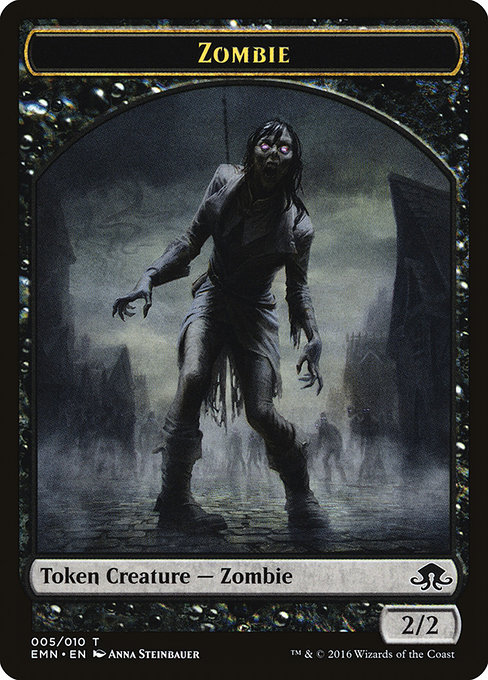
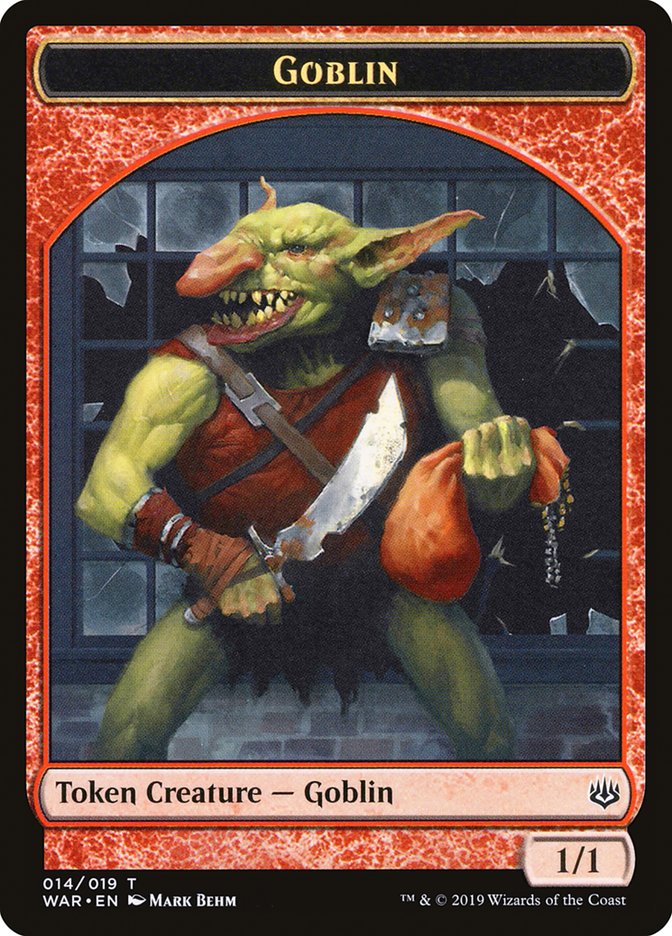
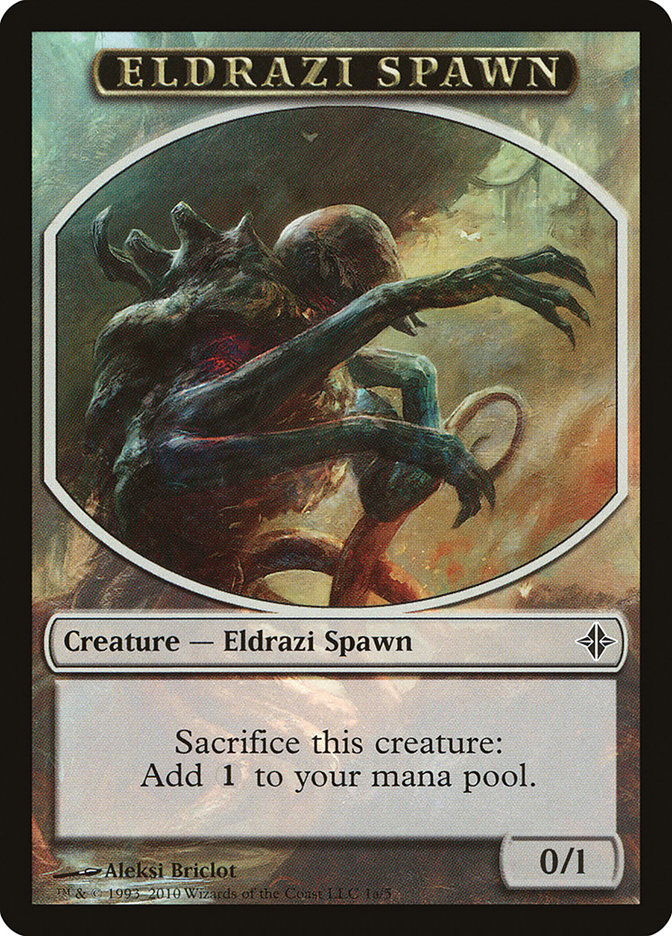
- Horde Tokens are treated as cards in all zones. They do not cease to exist when they move to a zone other than the battlefield.
- When a spell or effect controlled by the Horde says “create a Token”, that means to return a Token of that type from the graveyard to the battlefield. If no valid targets are available, the spell or effect fizzles. If a spell or effect attempts to create multiple tokens, and fewer than the stated number exist in the graveyard, the spell or effect returns all available targets to the battlefield.
- The Mana Value of a Horde Token is equal to the average of its power and toughness, rounded up.
These rules only apply to tokens that begin the game in the Horde deck - if the Horde is given control of any other tokens, all regular token-related rules apply.
Spellcasting
Any time the Horde draws a card, it immediately casts that card, as though it had Flash, for 0 mana.
If the Horde if forced to draw multiple cards simultaneously, it will cast them in the order they are drawn.
Making Mana
While the Horde doesn’t need mana to cast its spells, it may need mana to activate abilities or pay to respond to Survivor-controlled spells or abilities. In order to pay for these, Horde creatures all have an additional mana ability:
[Tap this creature]: Add X mana of any color, where X is this creature’s Mana Value.
The Horde will only use this ability when directed to by a specific card (as defined under the individual deck in this document), or when it is required to pay for a taxing effect. If multiple creatures are available to use as mana sources, the Horde will tap those that cause the least excess mana to be produced (choosing randomly if there is no clear best case).
Reminder: Horde Tokens do have a Mana Value, which is equal to the average of their power and toughness, rounded up.
Paying Taxes
If an effect would prevent the horde from doing something it would typically do (such as casting a spell or attacking) unless mana is paid, the Horde will tap creatures for mana to pay for that taxing effect. When selecting among available creatures to tap for mana, the Horde will always choose the creatures which generate the least excess mana. If there are still multiple options, choose one at random.
Such as “sacrifice a permanent unless you pay,” “counter target spell unless it’s controller pays an additional,”
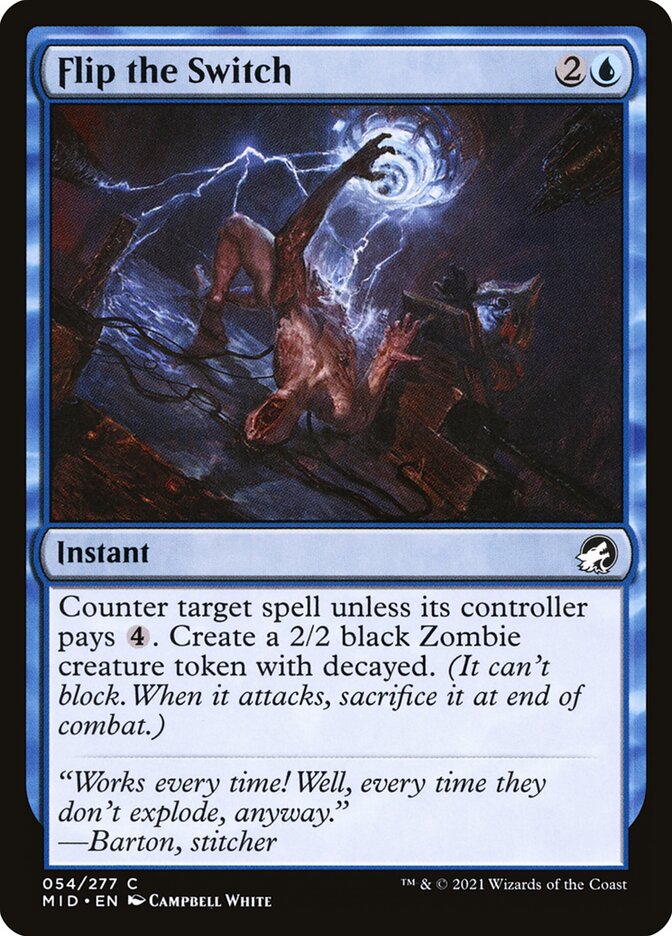
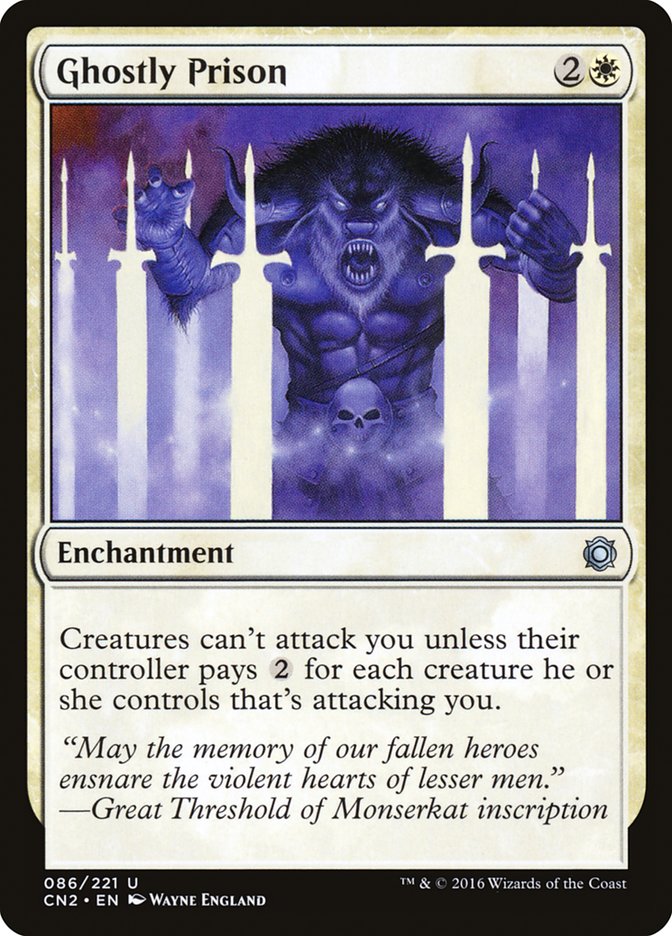
The Horde will never “plan ahead” to keep mana available for taxing effects which it has not yet been asked to pay.
Targeting
When the Horde must choose a target for a negative effect such as “destroy” or “exile,” it chooses the highest-Mana Value target controlled by the Survivors. If there are multiple valid targets tied for highest Mana Value, use any random method to choose between them.
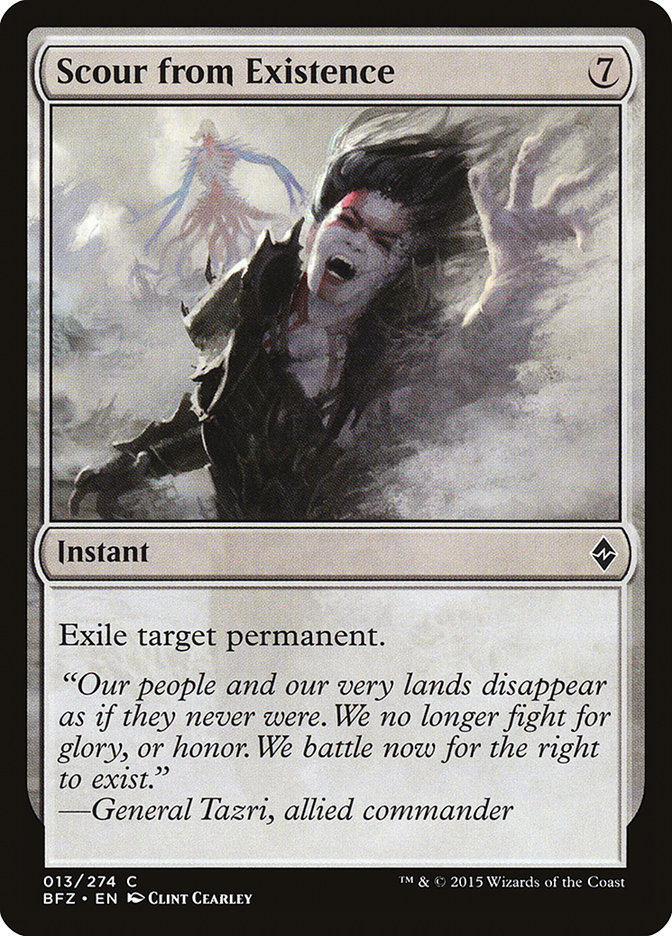
When the Horde must choose a target to deal damage to, it chooses the Survivors’ life total if that is an option. If players are not valid targets for the spell or effect, it will choose a creature to which it can deal lethal damage, with the following priorities:
- The creature with the highest toughness to which it can deal lethal damage.
- The largest number of creatures that can be dealt lethal damage
- The creature it can bring nearest to lethal damage.

In any cases of ambiguity, the target is chosen randomly from among the best available options.
The Golden Rule
The Horde decks and the rules outlined in this document aim to minimize the decisions that the Horde has to make, and provide clear, simple rules for those decisions that are expected to come up regularly. Despite this, Magic is a complex and ever-changing game, and there will inevitably be occasions when the Horde must make choices.
If there is an obviously correct choice, make that one. If not, choose randomly.
The difficulty here is that “obviously correct” is hard to define. If you have any doubt about a particular decision, defer to choosing randomly.
For example, assume you, the Survivors, have cast a spell that requires each player to sacrifice a creature.
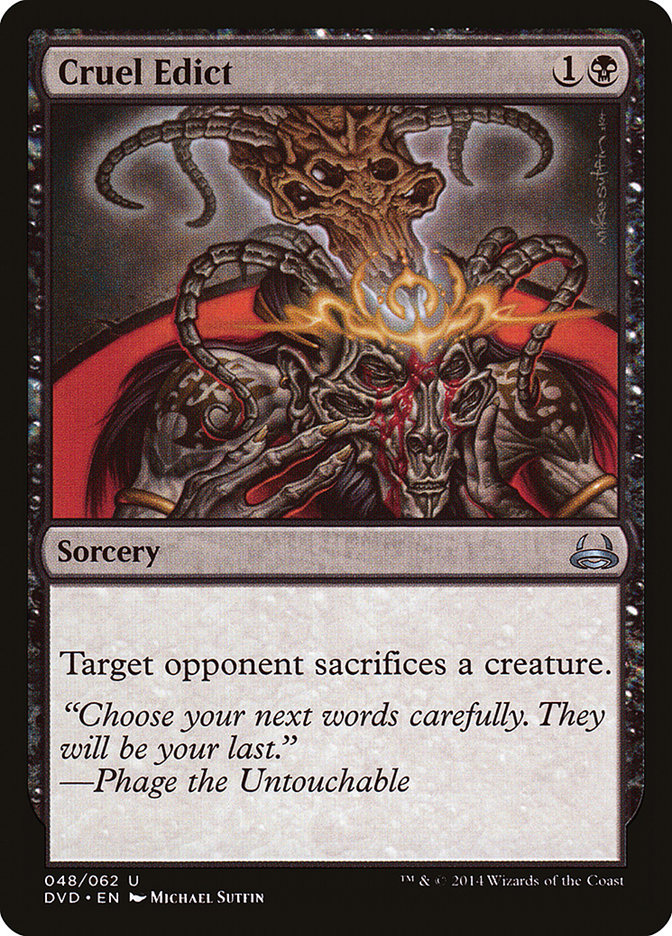

If the Horde has exactly one 2/2 Zombie Token and one 5/5 Zombie Giant Token on the battlefield, the correct choice is fairly obvious - the Horde will sacrifice the 2/2.

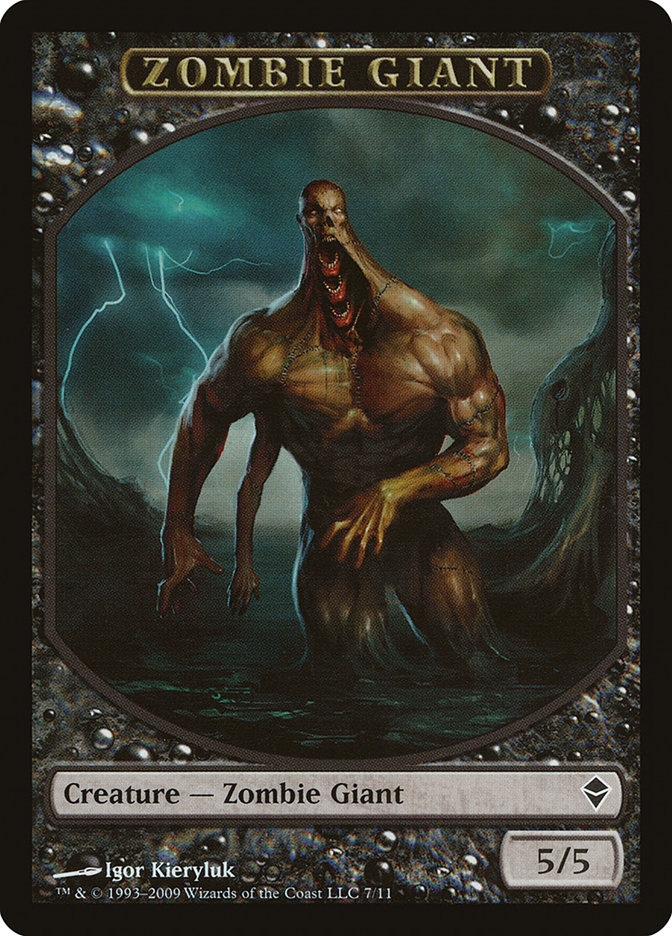
What if, on the other hand, the Horde has a 3/1 Stitchwing Skaab with Flying and a 5/5 Zombie Giant. Are the higher power and toughness on the Giant more valuable than the Flying on the Skaab? This would virtually always be a situation where a player would have to consider the board state, and make a judgment call - therefore, in the Horde’s case, it should be chosen randomly.
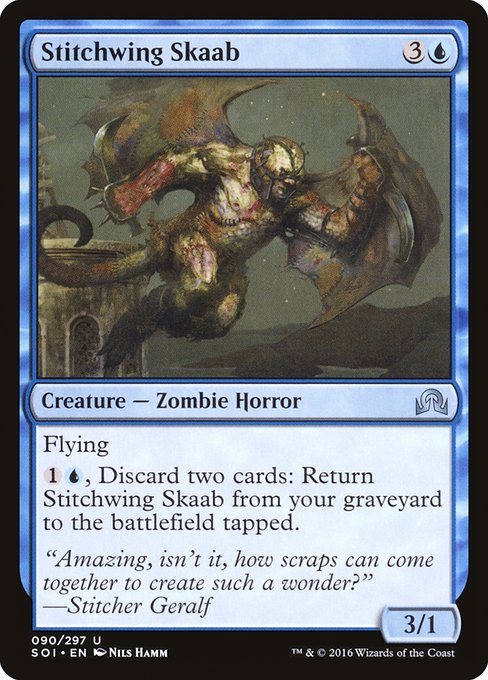

Let’s take a slightly more complex example…the Horde has a Cursed Minotaur (3/2 with Menace), a Blighted Bat (2/1 with Flying) and a Diregraf Captain (2/2 with Deathtouch, granting +1/+1 to all Horde Zombies, and deals 1 damage to each opponent when another Zombie dies). In this case, the Diregraf Captain is fairly obviously the most valuable, but the difference between the 3/2 Menace and the 2/1 Flying is less clear. In this case, it would usually be correct to rule out Diregraf Captain, and choose randomly between the other two. When in doubt, always defer to random choice.

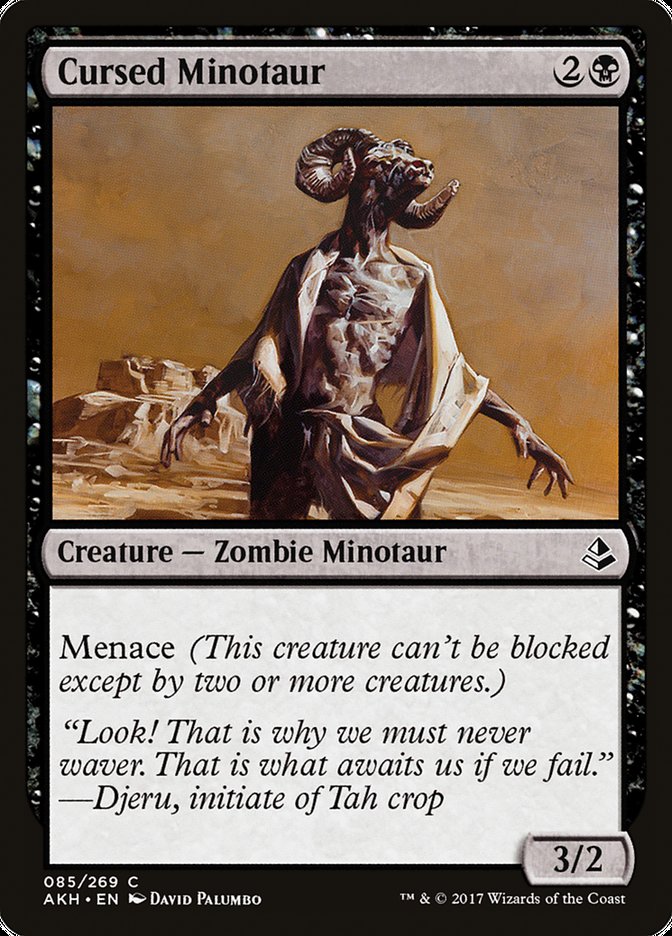
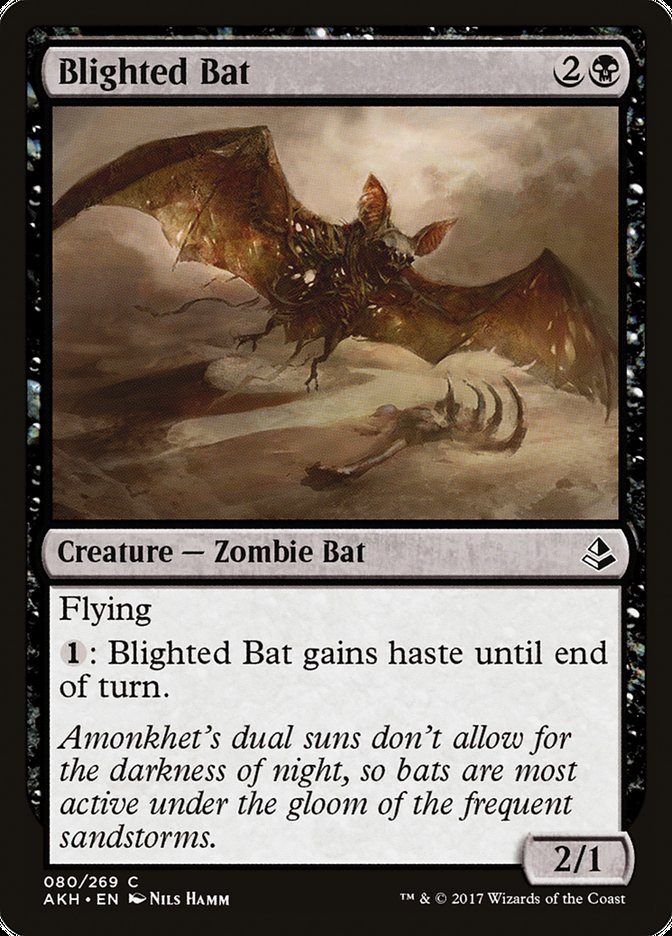
Assault Stage
Once the Survivors have taken their allotted Preparation turns, the Assault stage begins, and the Horde begins playing cards and attacking.
Here’s a detailed breakdown of what happens during each step and phase of the Horde turns:
Untap
The Horde will take no action and pass priority.
Upkeep
The Horde will take no action and pass priority.
Draw
The Horde draws one fewer cards than usual. This will normally mean it does not draw at all (during this step). The Draw Step does still occur, so effects that trigger on its occurrence will not be skipped.
First Main
At the beginning of the Horde’s first main phase, it draws cards from the top of its library and immediately casts them until either of these conditions are met:
- Three cards have been drawn and played
- A non-Token card is drawn and played.
Each spell should be fully resolved before the next card is drawn. This is relevant in cases where casting one spell causes another card to be drawn and, per Horde rules, immediately cast. In these cases, any cards drawn as part of the resolution of another spell are not counted toward the spells the Horde “naturally” draws that turn.
Combat
All Horde creatures have Haste, and attack each turn if able. If the Survivors control a Planeswalker, all Horde creatures attack the Planeswalker. If the Survivors control multiple Planeswalkers, the Horde chooses one at random.
Ordering Blockers
The Horde will order blockers to prioritize dealing lethal damage to, in order of priority:
- The highest toughness creature
- The largest number of creatures
- The creature it can bring closest to lethal damage
The Horde will not take any hidden information (such as cards in Survivors’ hands) into account, but will take activated abilities into account, and assume that all activated abilities are used to maximum effect. Where the Horde’s decision would be ambiguous, decide using any random method.
Second Main
The Horde will take no action and pass priority.
End
The Horde will take no action and pass priority.
Surge Stage
Just as the Survivors seem to have things under control, the remainder of Horde rushes forth in a final, desperate frenzy!
At the beginning of the Horde’s upkeep, if the combined number of cards in the Horde’s graveyard and in exile is greater than the number of cards remaining in the Horde’s library, the Surge stage of the game begins.
Tip: If you’re playing with physical cards, and if you represent the exile zone by placing exiled cards perpendicularly under your graveyard, this is extremely easy to check - physically compare to the two stacks of cards. If the Horde’s combined graveyard and exile is taller than its library, the Surge begins.
Time for Surge?


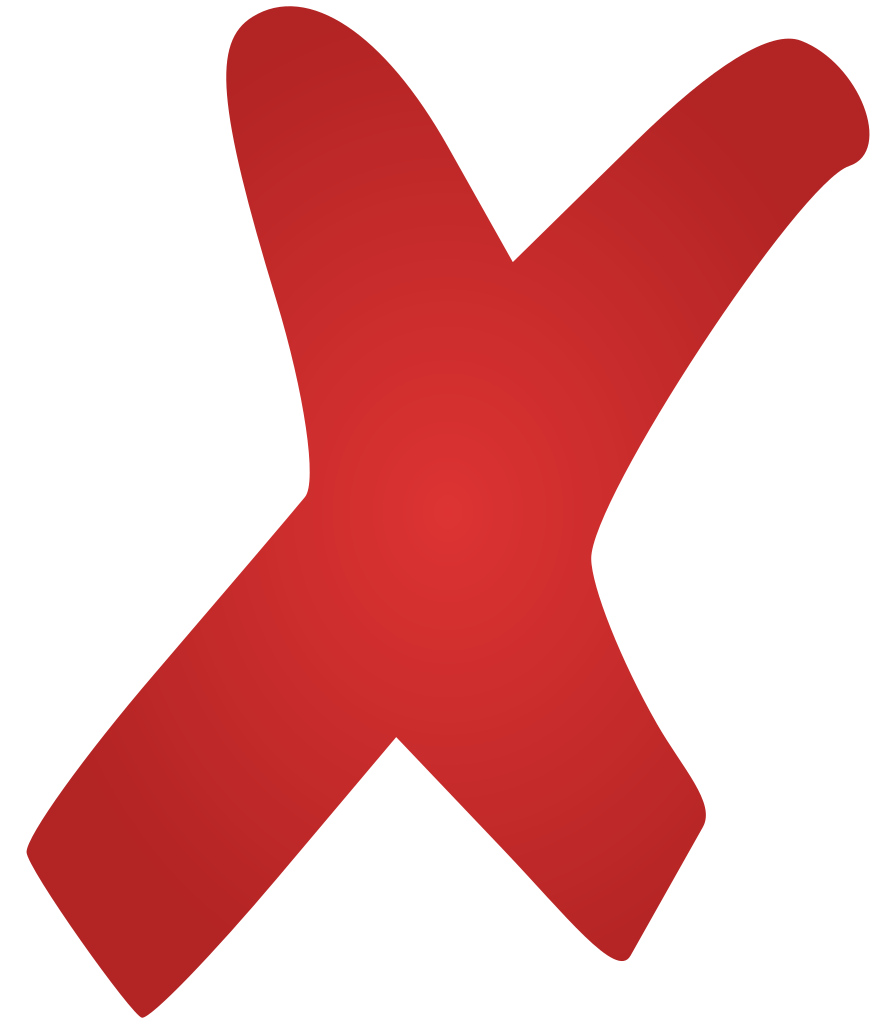

The only difference between the Assault Stage and the Surge stage is that the Horde will now cast an additional two cards from its library every main phase.
To make that explicit, the Horde behaves in exactly the same way as it did during the Assault Stage except for the First Main phase:
First Main
At the beginning of the Horde’s first main phase, it draws cards from the top of its library and immediately casts them until either of these conditions are met:
- Three cards have been drawn and played
- A non-Token card is drawn and played.
Then, the Horde draws and casts an additional two cards.

Epilogue Stage
Once the Horde’s library is empty, the game enters its final, Epilogue stage. The Horde will not attempt to draw from an empty library, and will not lose the game to effects forcing it to attempt to do so. It will continue to move through the standard phases of each turn, attacking and performing any other special actions indicated by the cards in play.
Victory Conditions
The Horde is defeated when, and only when, two conditions are true:
- There are no cards remaining in the Horde’s library.
- The horde has indefinitely lost its ability to deal damage to the Survivors. Assume the Survivors cannot lose the game to drawing from an empty library when checking this condition.
The second condition will most often be met when all Horde creatures have been removed from the battlefield. But, it is also sufficient to leave the Horde with creatures permanently unable to damage the Survivors. Examples include Pacifism or “doesn’t untap” effects, Survivor-controlled blockers who can block all remaining attackers without dealing lethal damage to each other, or even creatures like Gavony Trapper who could always execute the same series of simple actions each turn to prevent any Horde creatures from attacking.
Hunting
During the Epilogue Stage, all Survivor creatures without Defender gain the Hunting ability (properly defined later), allowing them to tap to fight a target opponent creature:
{{rulestext,font-family:”trebuchet ms”,margin-left:15px,width:90%
This allows the victorious forces to mop up any remaining opponents, and avoid game losses “on a technicality” (such as having a commanding board presence, but beign unable to deal with small creature with Skulk).
Interacting with the Horde
Attacking
Players may attack the Horde as they would any other opponent. Horde creatures will not block unless forced to do so by an in game ability.
For every 3 damage dealt to the Horde, the Horde mills one card. This is not restricted to combat, and includes all damage or loss of life. This damage is tracked as though the Horde were a permanent, and is accordingly removed during the Cleanup step.
This is a point of divergence from original Horde Magic rules, where every 1 point of damage milled a Horde card. This ratio leads to more interesting and challenging games in Limited formats.
Lifegain
For every 3 points of life that the Horde would gain, it draws (and immediately plays) a card.
If multiple instances of life gain less than 3 occur for the Horde, add it up and draw/play the appropriate number of cards for the Horde. This lifegain is lost as steps and phases end.
The only lifegain built into the Horde decks is in multiples of 3, so keeping track of incremental numbers should come up very rarely. Losing “floating” lifegain at steps and phases is purely to ease memory/tracking issues.
The Horde’s Hand
If an effect would cause a Survivor to interact with the Horde’s hand, reveal the top 3 cards of the Horde’s library. The Horde’s hand consists of those cards until the effect is resolved, at which point any remaining cards are returned to the top of the Horde’s library in a random order.
Effects that would cause a card to be placed in the Horde’s hand instead place them on top of the Horde’s library.
Drawing
If the Horde draws a card, it reveals the top card of its library and immediately plays that card, ignoring any mana costs or timing restrictions. If, despite these exceptions, the card cannot be played, it is returned to the top of the Horde’s library.
Discarding
If the Horde would discard any number of cards, it mills that number of cards instead.
Hunting
Under certain conditions, some or all of your creatures may gain the Hunting ability, which states:
{{rulestext,font-family:”trebuchet ms”,margin-left:15px,width:90%
As described above, all Survivor creatures are granted this ability during the Epilogue Stage. It is also used when playing against the Eldrazi Horde, as described in that section of this document.

Horde Deck - Zombies
It’s a tale as old as the multiverse…some scheming God, talented young necromancer, or supernatural phenomenon throws the circle of life into reverse, and the dead decide they’re no longer content to rest. They spill forth from their tombs and sepulchers, consuming all they encounter, and reclaim their civilizations from the most recent generation, who so rarely appreciate the sacrifices of their forebears. Of course, that’s not how the locals experience it. For them, it’s the opposite of mundane or poetic - most, I suppose, die horrifically at the hands of their recently departed loved ones, then rise to join their horrific ranks. Oh, that’s…that’s you? You’re alive? Well…I’m sure the dead won’t prevail in your case…I mean, you know, sometimes the living come out on top! I expect you’ll be fine.
The very first Horde deck was a Zombie deck, and it’s only fitting they’re included here as well. This Horde pressures the Survivors with evasive creatures and discard effects, but the biggest threat is recursion via Graf Harvest. If either copy of Graf Harvest is cast and sticks, the non-Token zombies will start generating Zombie Tokens out of the graveyard until they run out of fuel. While they’re at it, the entire Horde has Menace.
Decklist
| Tokens | |
| Zombie | 21 |
| Zombie Giant | 4 |
| Spells | |
| Graf Harvest | 2 |
| Noosegraf Mob | 1 |
| Rottenheart Ghoul | 2 |
| Miasmic Mummy | 2 |
| Smallpox | 2 |
| Blighted Bat | 2 |
| Stitchwing Skaab | 1 |
| Advanced Stitchwing | 1 |
| Crow of Dark Tidings | 2 |
| Cursed Minotaur | 1 |
| Thraben Foulbloods | 1 |
| Hound of the Farbogs | 2 |
| Rancid Rats | 2 |
| Gavony Unhallowed | 2 |
| Diregraf Captain | 2 |
| Total | 50 |
Tokens
The core of the Horde deck is, of course, the Zombie tokens. Individual 2/2s are generally manageable, but they can easily add up more quickly than the Survivors can kill them. The 5/5 Zombie Giants are the truly challenging thing to contend with, of course. Hitting a string of them early in the game can spell certain doom for the Survivors, but facing down multiple in the final turns of the game can overrun all but the most stalwart defenses.


Token Generators
The assault begins to lighten, and you allow yourself a moment of hope - could the end be near? Your relief is short-lived. The monsters are…recycling…their fallen comrades, using some dark force to fuse together the most intact pieces of their defeated brethren into newly-animated abominations, which once again shamble forth.
Graf Harvest
This card is the centerpiece of the Zombie Horde deck. Between granting Menace to the Horde’s entire battlefield and flooding the board with Zombie tokens from the graveyard, it can quickly cause an otherwise stable game to spiral out of control.
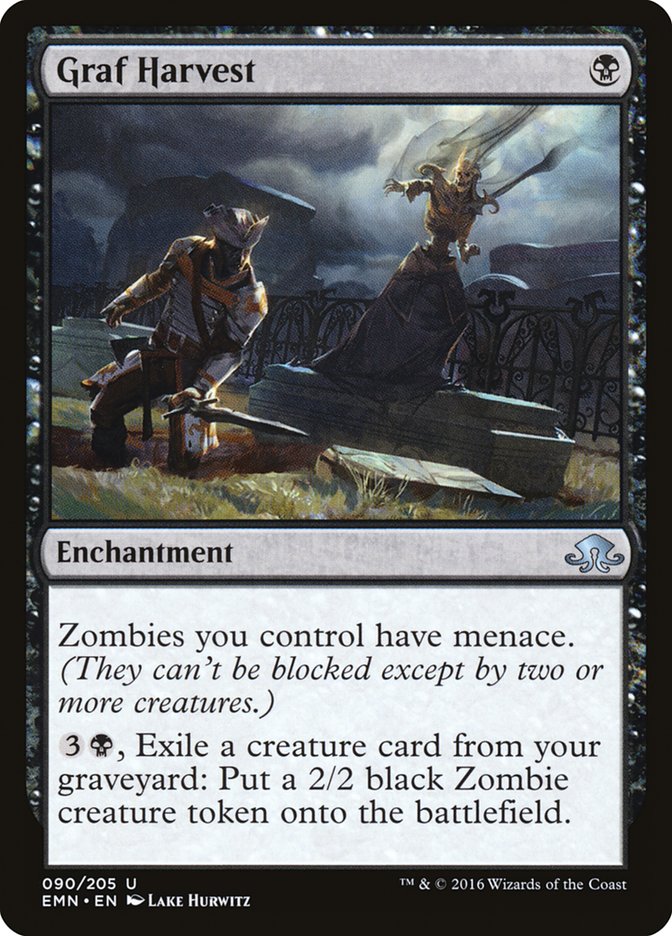
In fact, Graf Harvest is so powerful in this context that it requires both errata to sacrifice it when it’s out of targets in the graveyard and a Directive to only use non-Token creatures to pay for its activated ability:
Errata for Graf Harvest
At the beginning of each Upkeep, unless there are one or more Token creatures and one or more non-Token creatures in your graveyard, sacrifice Graf Harvest.
Directive:
While Graf Harvest is in play AND If the Horde controls non-Token creatures with a combined mana value of at least 4, THEN tap those creatures for mana and activate the second ability of Graf Harvest. After that ability resolves, If there are sufficient non-Token creatures on the battlefield, and valid targets in the graveyard, repeat this process.
Where multiple creatures are available to use as mana sources, choose those that cause the least excess mana to be produced. If this is unclear, or there are multiple equivalent options, choose randomly.
Noosegraf Mob

Errata for Noosegraf Mob
Whenever a player casts a non-Token spell,…
Compared to the other Horde decks, Zombies has comparatively few token makers, with a single copy of Noosegraf Mob being the other. It presents interesting choices that vary with the state of the game. If the Horde plays it very early in the game, there may be no Zombie Tokens in the Horde’s graveyard to recur, so Survivors can cast spells freely (its ability will trigger and it will lose a counter - only the token creation clause will fizzle). When there are Zombie tokens in the Horde graveyard, the Survivors must take the Noosegraf triggers into account (both from their own spells, and the number of triggers they can likely expect during the next Horde turn) in determining what to cast and when.
Discard
What could be more core to Black’s color identity than discard? Each of these discard spells has functional errata to cause only the Survivors to suffer its ill effects.
Rottenheart Ghoul

Errata for Rottenheart Ghoul
When Rottenheart Ghoul dies, each opponent discards a card.
Miasmic Mummy
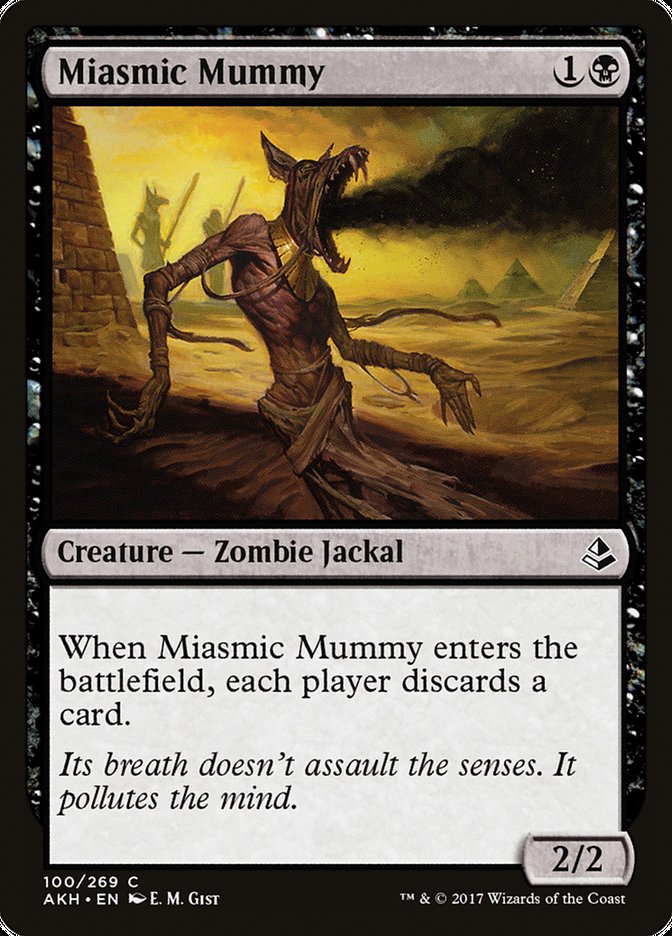
Errata for Miasmic Mummy
When Miasmic Mummy enters the battlefield, each opponent discards a card.
Smallpox
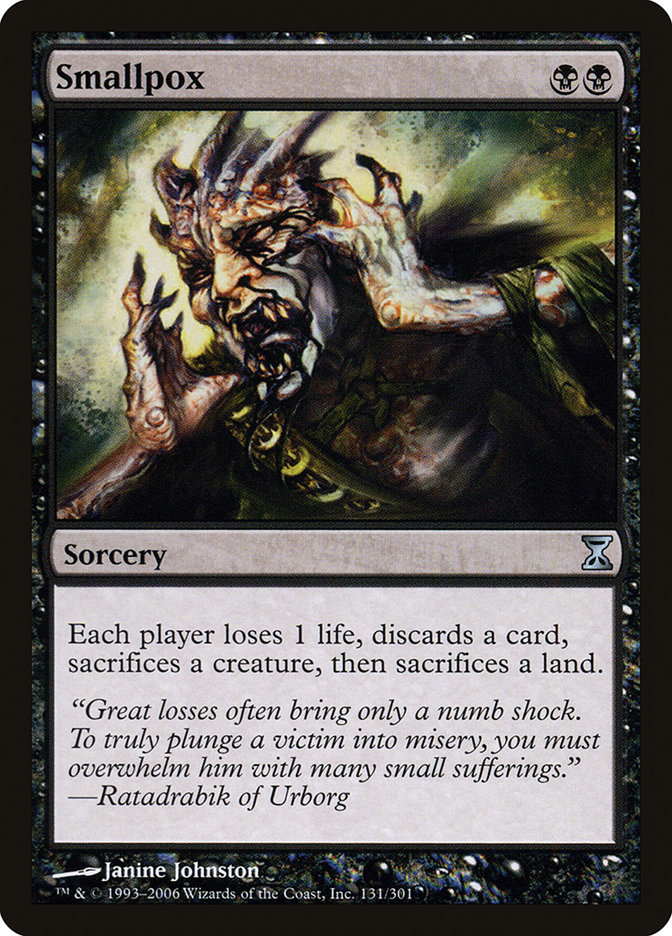
Errata for Smallpox
Each opponent loses 1 life, discards a card, sacrifices a creature, then sacrifices a land.

Menace
There have been a few permutations over the years (first Fear and then Intimidate), but since the beginning of Magic there have been Black creatures with evasion based on the idea that opponents could not summon the courage to stand against them.
Cursed Minotaur

Delerium is cumbersome to track and poorly supported by this deck, so these Zombie doggos are errated to rely on Threshold instead.
Thraben Foulbloods
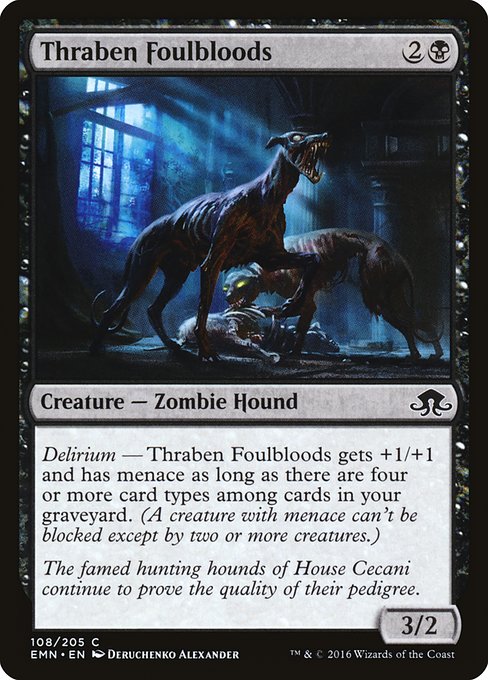
Errata for Thraben Foulbloods
Threshold - Thraben Foulbloods gets +1/+1 and has menace as long as there are seven or more cards in your graveyard.
Hound of the Farbogs

Errata for Hound of the Farbogs
Threshold - Hound of the Farbogs has menace as long as there are seven or more cards in your graveyard
Skulk
Rancid Rats

Most of the design of Horde magic incentivizes larger creatures. Rancid Rats provide a counter-balance, necessitating small blockers and punishing 0-toughness Defenders. A non-trivial number of playtest games ended with a Horde victory of one or two Rancid Rats whittling down the Survivors life total while while they helplessly drew the last card from their deck, unable to answer such a seemingly insignificant threat.
Flying
In virtually every Limited format, decks have to be prepared to deal with fliers. The fliers in this deck are prevalent enough that there will very rarely be a deck with enough direct removal to one-for-one the Giants and the fliers, and these powers are high enough to generally compel some interesting trades.
Reminder: The Horde will never activate the abilities on any of these creatures (since it has no Directive to do so).
Blighted Bat

Stitchwing Skaab

Advanced Stitchwing
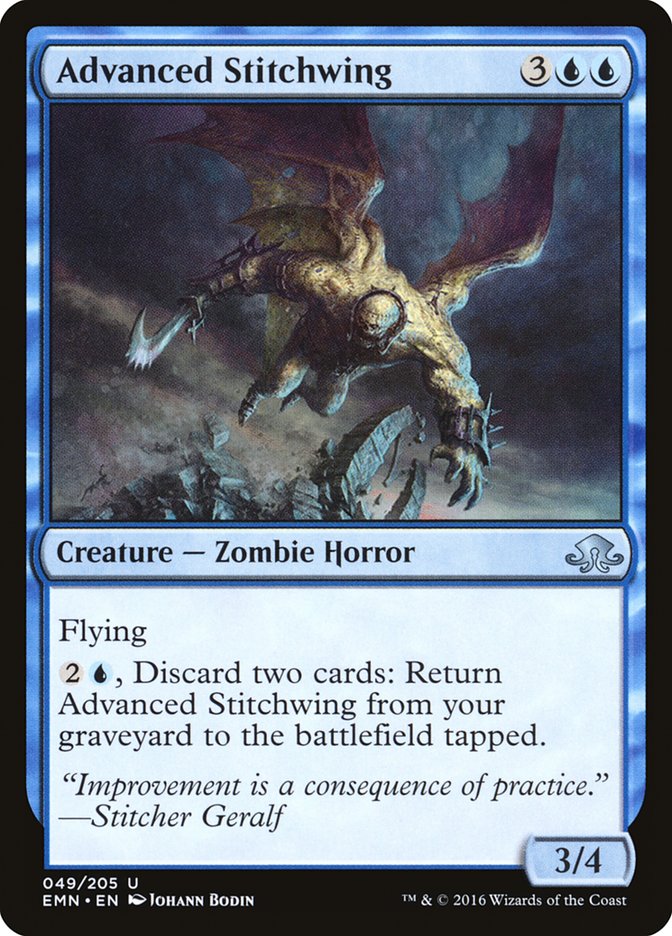
Crow of Dark Tidings
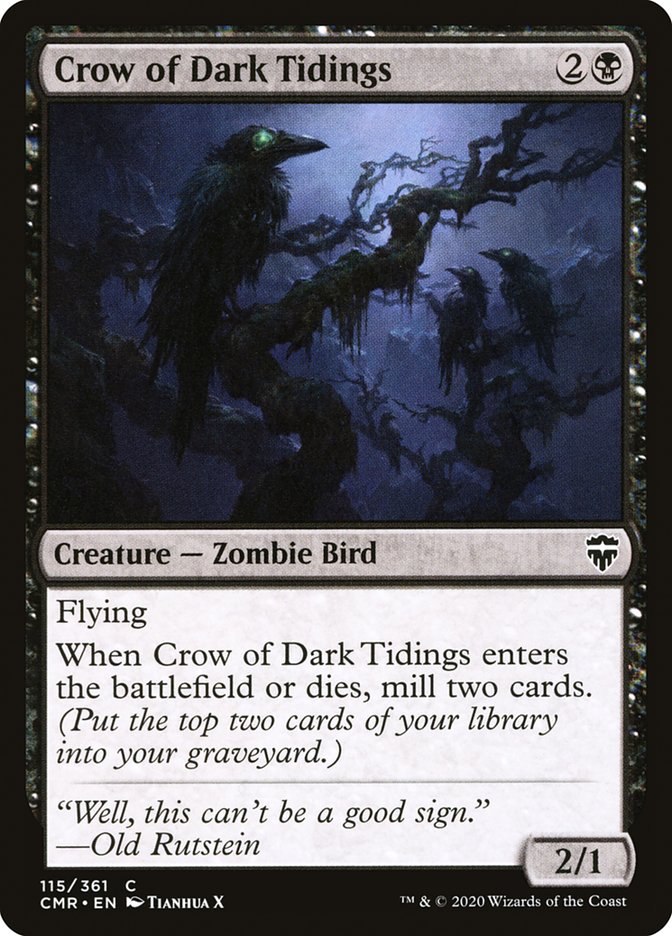
The Crows’ second ability may seem like pure upside for the Survivors, and often it is. Other times, however, it unexpectedly causes the Surge to begin earlier than the Survivors were prepared for, or prolong a Graf Harvest that appeared to have nearly run out of non-Tokens to exile.

Gavony Unhallowed

Both of these creatures synergize powerfully with Graf Harvest - they will generally be tapped to activate the harvest, so unable to be removed via blocking while benefiting from every Zombie that the Survivors do manage to kill during the Harvest.
Diregraf Captain

Horde Deck - Goblins
Everyone knows that goblins are dangerous, but usually it’s in the same sense that a stray dog is dangerous. It knows you’re dangerous, so as long as you don’t make it feel threatened or cornered, it’ll probably keep to itself and go on its way. Of course, with the dog, there’s the possibility that, carefully and over time, you could befriend it with gifts of food. If you try to befriend the goblin, you’re just going to end up getting stabbed. But, none of that’s particularly relevant, because you’re not dealing with a goblin…you’re dealing with goblins, plural. What’s worse, someone or something seems to have organized them…given them a shared purpose. They’ve been “building,” if you can call it that, crude shrines and structures. Your patrols have been tearing them down when they come across them, sending the occupants scurrying, but new ones are appearing at an alarming rate, and in ever-closer proximity to your settlements.
Fundamentally, every Horde deck has a go-wide strategy. That said, this deck goes widest of the current Limited Horde battlebox. There are many creatures that create additional tokens when they enter or leave the battlefield, bolstered by the “Kluge” mechanic which lets you remove Horde-buffing Enchantments in a variety of ways, but at the cost of creating additional Goblins when you do (when you tear down their structures, goblins spill out of them and join the attacking force). To capture a bit more mono-Red flavor, there’s some artifact hate from Goblin Trashmaster, some unpredictable direct damage, and a bit of coin-flipping.
Decklist
| Tokens | |
| Goblin | 25 |
| Spells | |
| Goblin Caves | 2 |
| Goblin Shrine | 2 |
| Goblin Oriflamme | 2 |
| Goblin War Drums | 1 |
| Raid Bombardment | 1 |
| Goblin Marshal | 2 |
| Siege-Gang Commander | 2 |
| Goblin Rabblemaster | 1 |
| You See A Pair of Goblins | 3 |
| Goblin War Strike | 1 |
| Volley Veteran | 1 |
| Goblin Chainwhirler | 2 |
| Goblin Trashmaster | 2 |
| Goblin Pyromancer | 1 |
| Ib Halfheart, Goblin Tactician | 1 |
| Pashalik Mons | 1 |
| Total | 50 |
Tokens
The Tokens in this deck are simple - they’re 1/1 Goblins. Individually, they’re the least threatening attackers in Limited Horde . But, very rarely is “individually” relevant. A large number of the spells in the Goblin deck create tokens when they enter or leave the battlefield, and many of them also buff all Goblins on the battlefield…some continually, others as a one-time effect. The result is, you can never predict whether the choice to leave just that one Goblin alive this turn is going to be trivial to deal with the following turn, or is suddenly going to be one of many high-power attackers, which you don’t have enough blockers to deal with.

Kluges
The Goblins are erecting…well, it would give them too much credit to call them “fortifications,” but they’re building something out there. You can, and probably should, send your forces to tear them down, but that could leave your settlement defenseless in the meanwhile…
Each Enchantment in the Goblin deck is errated to also be an Artifact and to have the additional subtype “Kluge.” All Kluges inherently have the Dismantle ability:
Dismantle - Tap X creatures, where X is this card’s Mana Value: Sacrifice this Kluge. Any player may activate this ability. You may not pay this cost by tapping creatures with summoning sickness. Activate only as a Sorcery.
When this is destroyed, create X 1/1 Red Goblin Tokens, where X is this Kluge’s Mana value.
If that seems like a lot of text, think of it this way…instead of attacking, you can send two or three of your creatures (depending on the target Kluge’s Mana Value) to tear the thing down. When you do, a handful of goblins scurry out of it, and join their brethren in the assault on your settlement.
Kluges create a lot of interesting and consequential decision points. If the Survivors let the Kluges accumulate on the battlefield, they’ll have fewer and fewer creatures with sufficient power and toughness to profitably block incoming Goblin Tokens. When they tap potential blockers to destroy a Kluge, though, they will rarely have enough untapped creatures to block the tokens created by destroying the Kluge and the new Goblins played by the Horde on the following turn…to say nothing of any Goblins that were already on the battlefield.
Secondarily, the Kluge mechanic gives small (low-toughness) creatures a useful purpose in the mid- and late-game. Creatures that only trade one-for-one with Horde Tokens tends to a losing proposition, given the much larger creature count in the Horde decks. A 1/1 is just as good as a 5/5 at dismantling a Kluge, though…

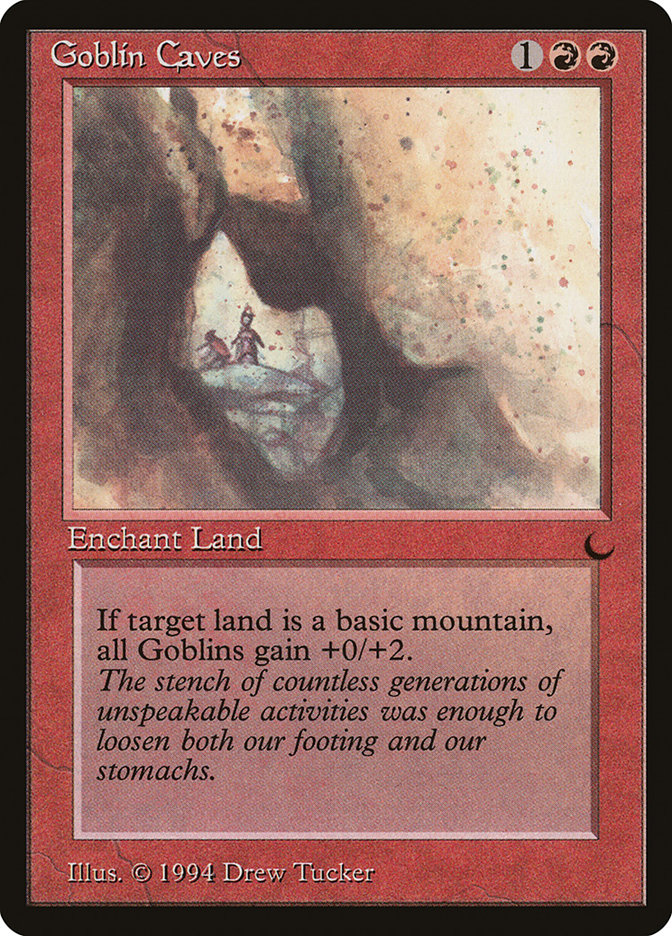

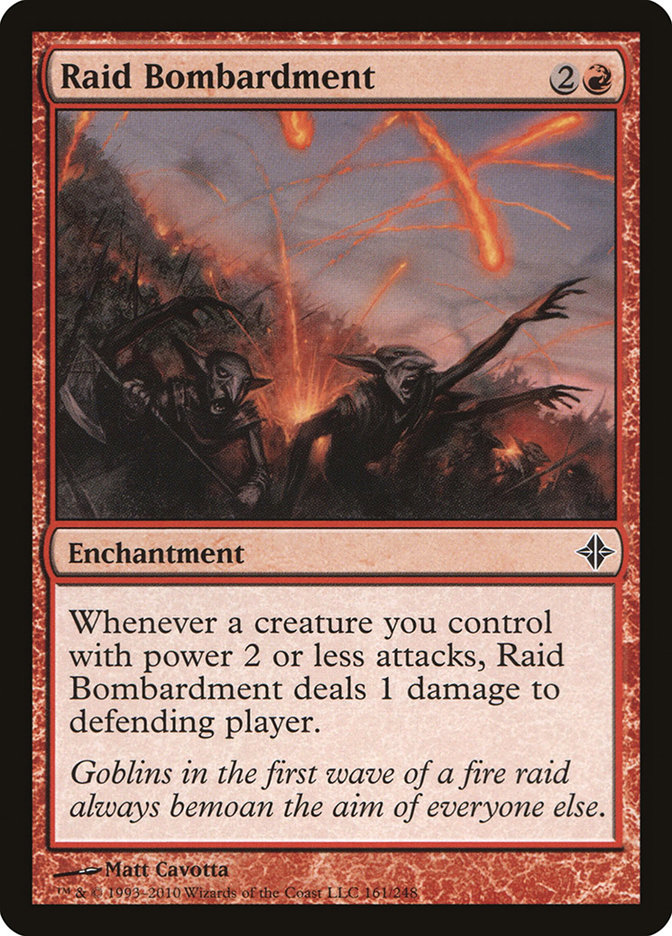
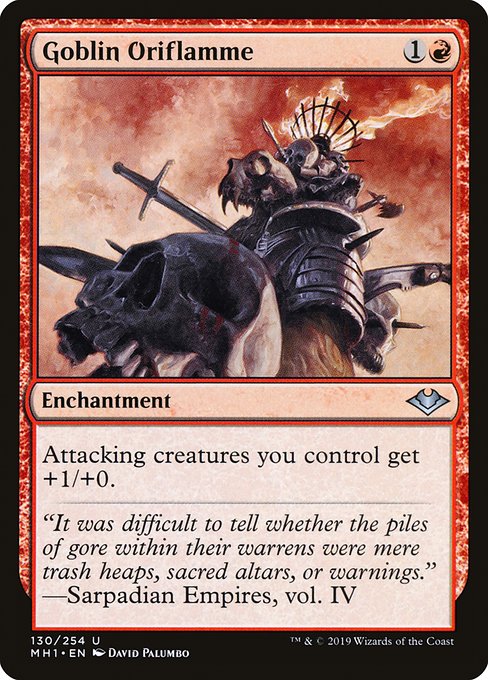
Token Generators
These creatures assure that the battlefield will never stay empty for long.
Goblin Marshal
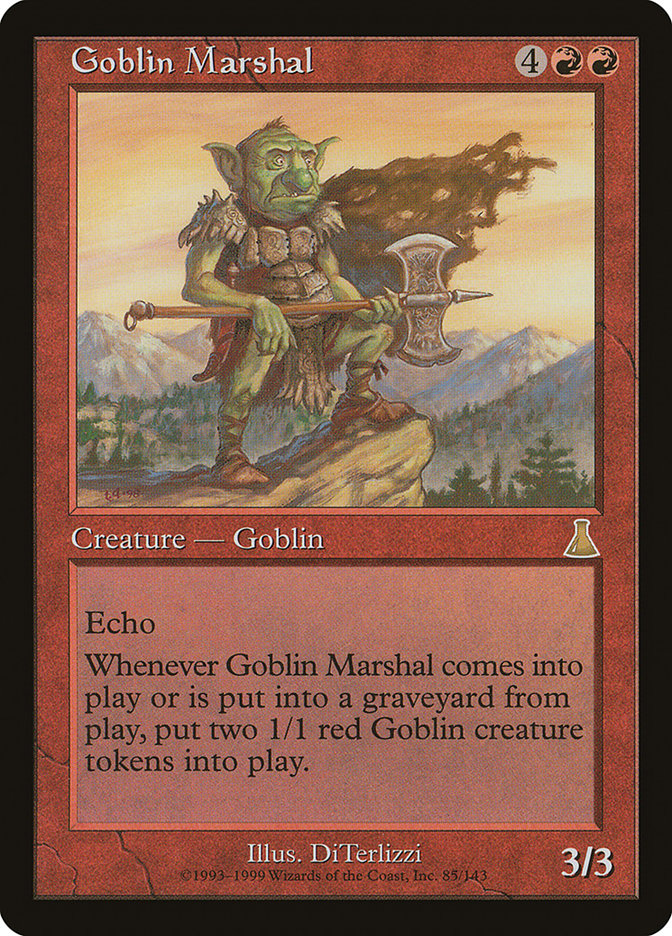
Errata for Goblin Marshal
Goblin Marshal’s Echo cost is 0.
Goblin Rabblemaster
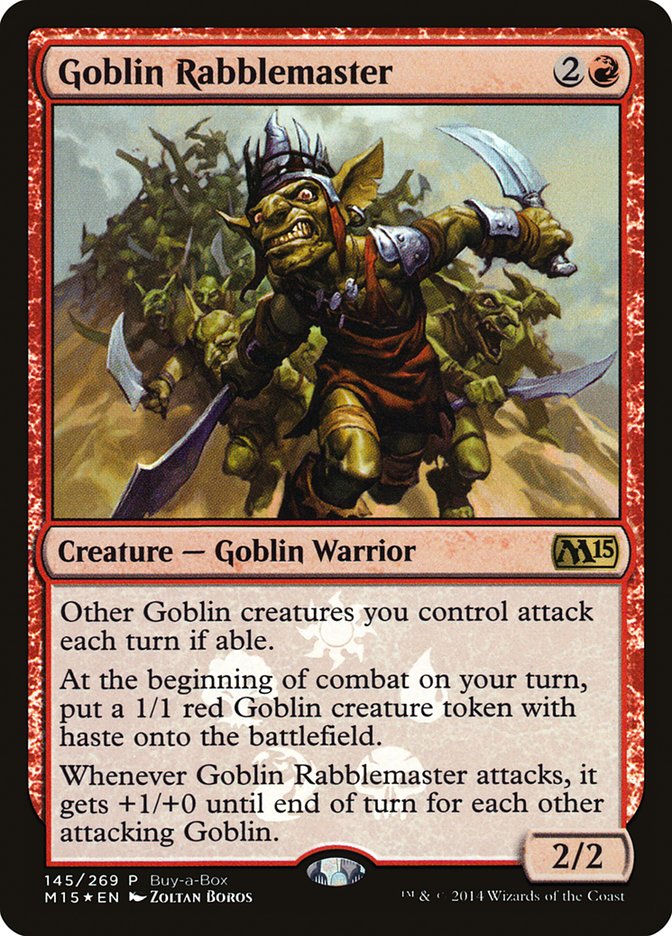
Siege-Gang Commander

Siege-Gang Commander is one of a number of creatures in the Goblin deck that can sacrifice Goblins for some effect. Each is addressed individually below, but as a rule, any mana costs to activate these abilities are removed via functional errata, and the Horde has Directives to use these abilities when any non-Token Goblin would otherwise die…unless it would dealing lethal damage to opposing creature.
Errata for Siege-Gang Commander
0, Sacrifice a non-Token Goblin: Siege-Gang Commander deals 2 damage to any target.
Directive:
IF Siege-Gang Commander is on the battlefield AND a non-Token Goblin creature under your control would otherwise be destroyed or exiled, THEN unless doing so would prevent that creature from dealing lethal damage to an opposing creature in combat, sacrifice that creature to activate Siege-Gang Commander’s ability.
When this ability is used, standard Horde targeting principles are applied, so the damage will targeted directly at the Survivors life total.



You See a Pair of Goblins
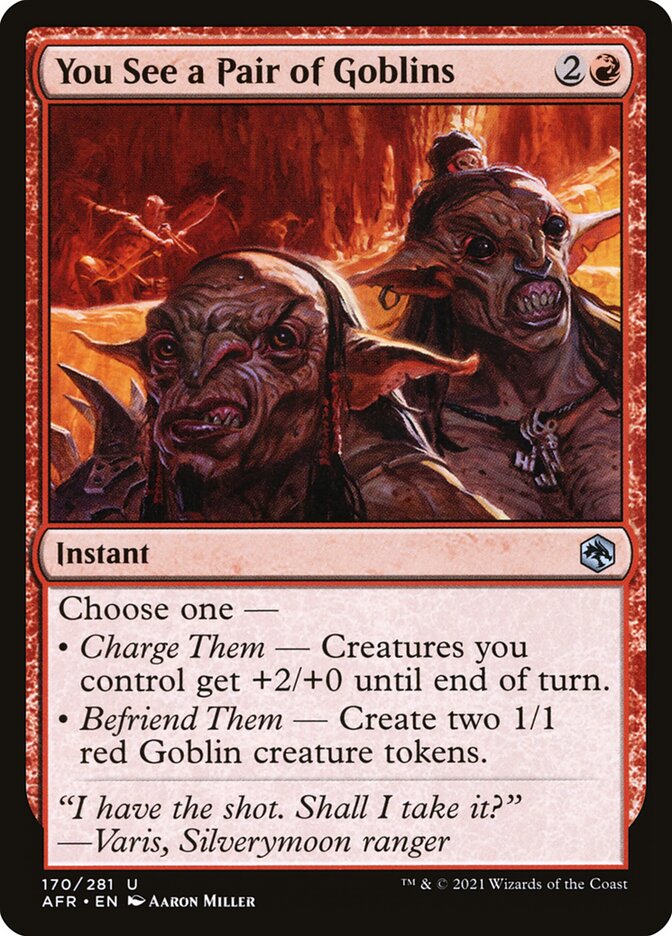
What’s a Goblin deck without a bit of chance? The Horde has no special Directive for selecting the mode on this card, so it is chosen randomly when cast. This is one of the cards where the sequence it’s cast in, relative to other cards drawn the same turn, is relevant. It will only give +2/+0 (when that mode is chosen) to Goblins already on the battlefield.
Direct Damage
Certainly Red’s most defining ability, and possibly the most iconic ability of any color in Magic, Red Does Direct Damage. To stay doubly on theme, the amount is based on the number of Goblins already in play.
Goblin War Strike

Volley Veteran
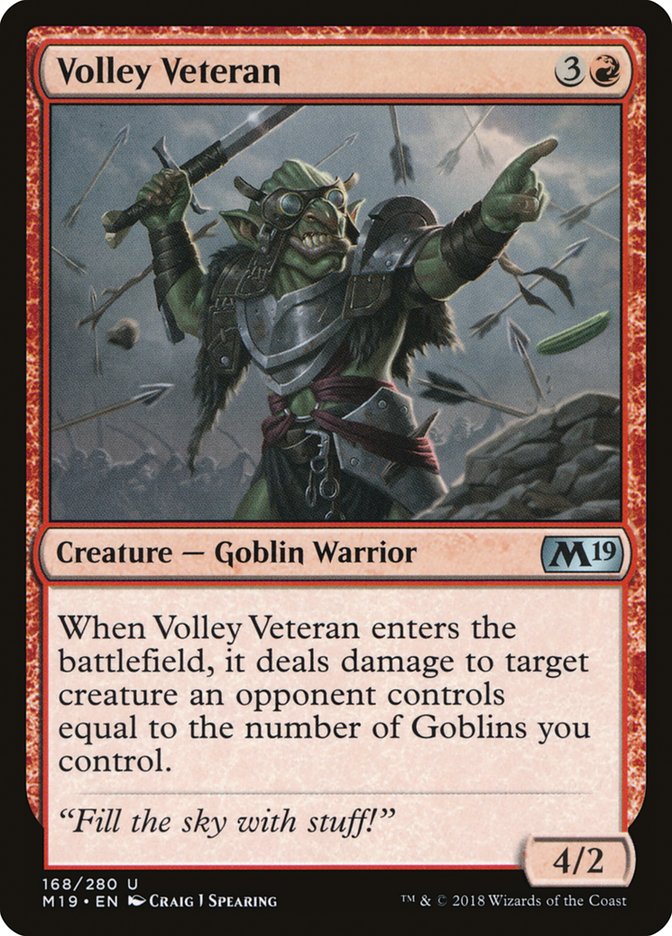
Refer to “Targeting” under “Horde Fundamentals” above for determining which Survivor creature the Volley Veteran will aim at.

Goblin Chainwhirler
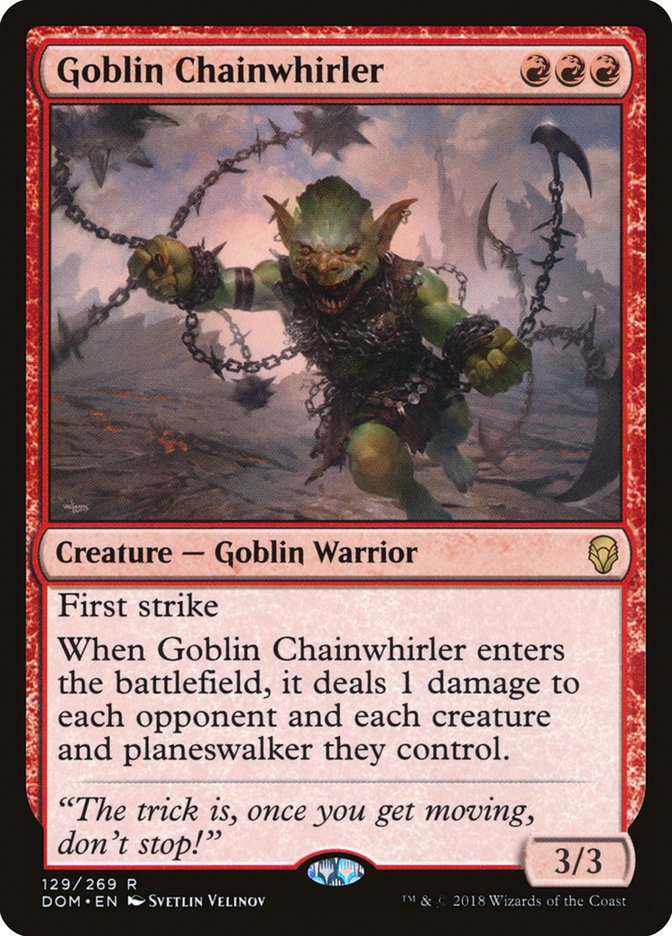
The numbers may not look too bad if you haven’t played against this card before, but it can be quite difficult to make good blocks when all of your creatures have already taken a point of damage…particularly for a 3/3 with First Strike.
Goblin Pyromancer
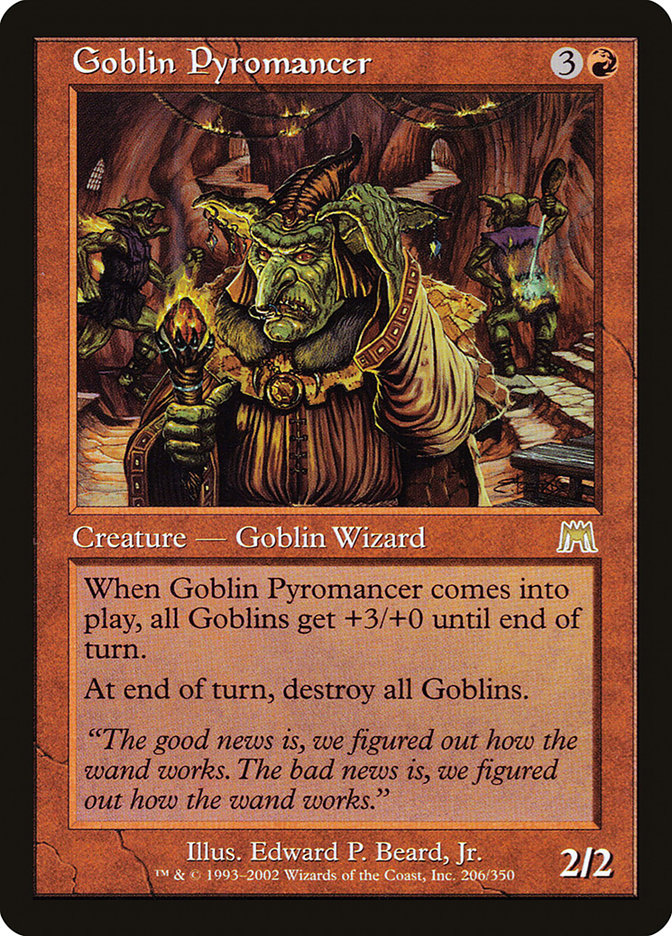
A nice touch of chaos! If you manage to survive the turn that Goblin Pyromancer hits the battlefield, the Horde will have to start rebuilding from scratch. But, that’s a big “IF”…
Goblin Trashmaster
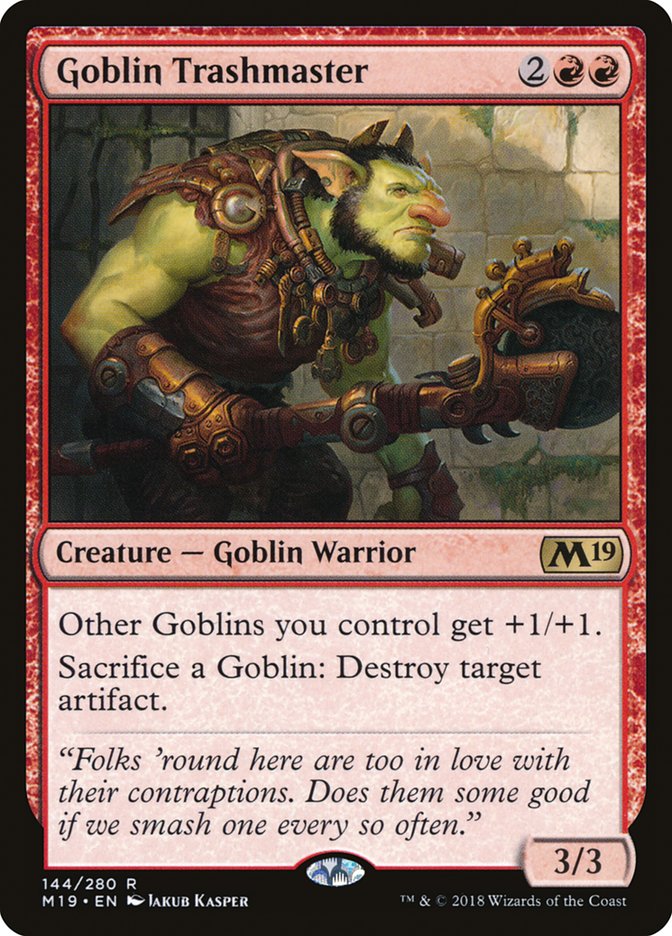
As with Siege-Gang Commander, the Horde will only sacrifice non-Token Goblins who are about to otherwise die (unprofitably) to activate Trashmaster’s effect. And what would happen, you ask, if both are on the battlefield at the same time? It’s the rule for the Horde in general, but it’s particularly appropriate in a Goblin deck…you choose randomly.
Directive:
IF Goblin Trashmaster is on the battlefield AND there is at least one targetable Artifact under the Survivors’ control AND a non-Token Goblin creature under your control would otherwise be destroyed or exiled, THEN unless doing so would prevent that creature from dealing lethal damage to an opposing creature in combat, sacrifice that creature to activate Goblin Trashmaster’s ability.
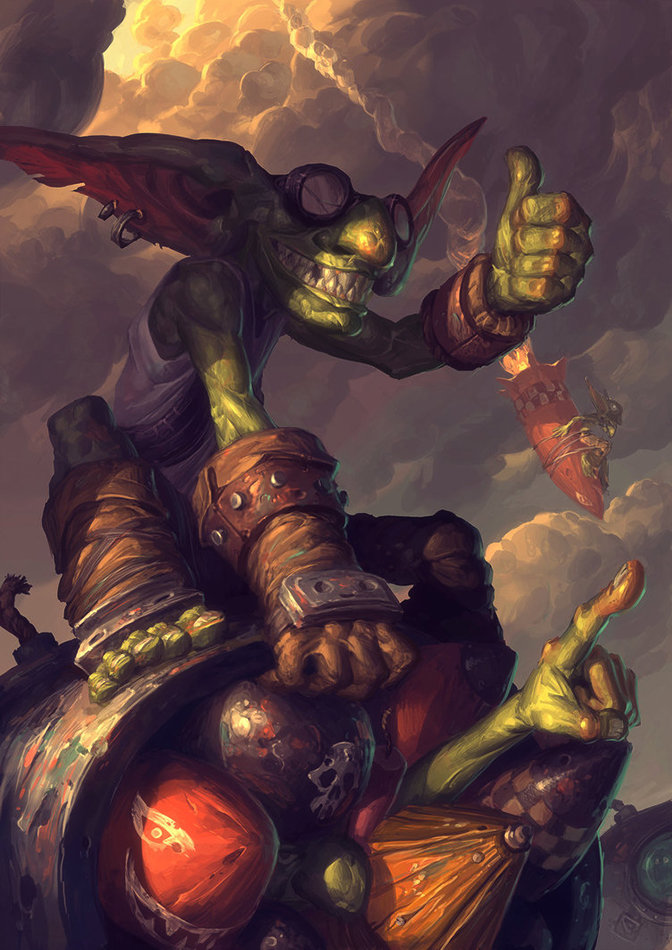
On the whole, Legendary creatures aren’t included in the Horde decklists since the Horde is meant to represent a generic threat encountered on many planes. But, these Goblins are just too FUN, and what do Goblins represent if not fun? Besides, look at Ib’s little face. He’s doing a blep!
Ib Halfheart, Goblin Tactician
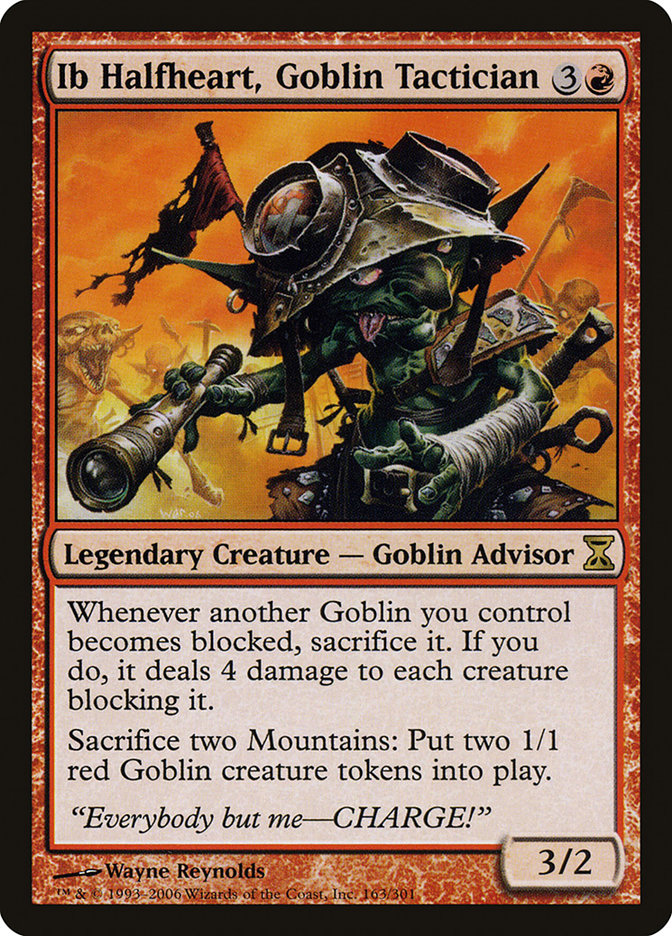
In at least partial seriousness, though, these two can be said to represent archetypes rather than individuals - the leaders who have compelled their near-feral kin to organize into a legitimate threat to the Survivors.
Pashalik Mons
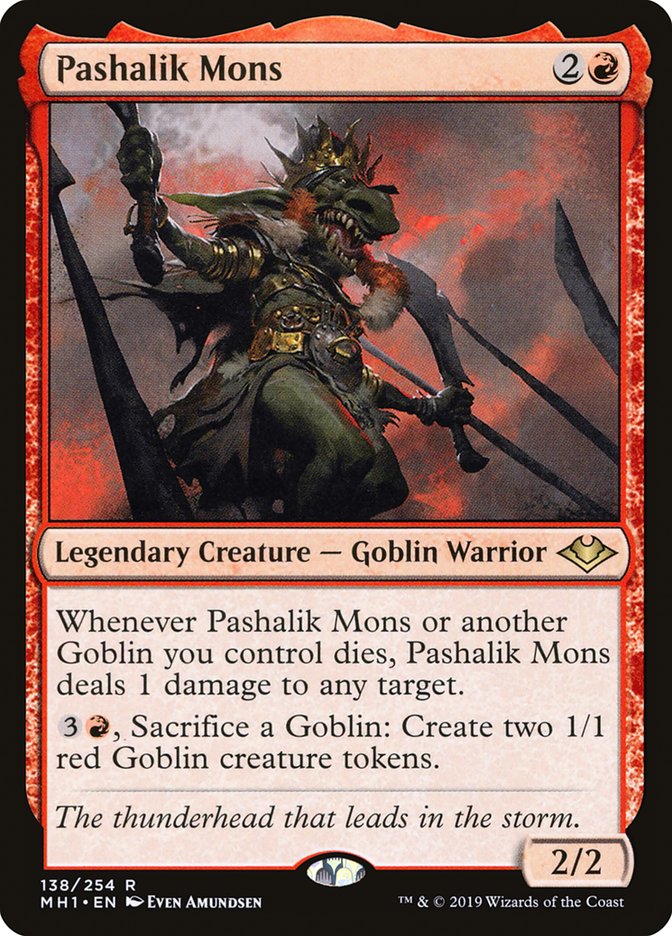
Pashalik follows standard Horde targeting rules as explained in “Horde Fundamentals” above, so his “on death” triggers will generally be directed toward the Survivors’ life total.
As with similar abilities earlier in the list the mana cost for Pashalik’s sacrifice ability is removed, it is activated only to sacrifice non-Token Goblins who are about to die anyway.
Errata for Pashalik Mons
0, Sacrifice a non-Token Goblin: Create two 1/1 red Goblin creature tokens.
Directive:
IF Pashalik Mons is on the battlefield AND a non-Token Goblin creature under your control would otherwise be destroyed or exiled, THEN unless doing so would prevent that creature from dealing lethal damage to an opposing creature in combat, sacrifice that creature to activate Pashalik Mons’ ability.
Horde Deck - Eldrazi
Everyone assumed the courier was drunk at first. When she didn’t sober up, they decided she was just crazy. But when the next patrol showed up - well, the half of them that made it - they were in the same state, and rambling about the same twisted monsters. Then, the rift formed. At night, you can see it glow, pulsing on the horizon. You’ve lost half your scouts, but those who’ve made it back with their minds sufficiently intact to speak describe the Things…whatever they are…pouring themselves into the rift. They’re torn apart, but the rift grows, and something is clearly trying to push through. What, no one can tell you…they can’t seem to wrap their minds around what they’ve seen.
The Eldrazi Horde uses a controlling strategy, delaying the game via sweepers and single target removal until it reaches critical mass to start playing out very large, powerful creatures. This is accomplished mechanically by using two decks.
Vanguard Decklist
| Tokens | |
| Eldrazi Spawn | 20 |
| Eldrazi Horror | 5 |
| Spells | |
| Kozilek’s Predator | 3 |
| Dread Drone | 3 |
| Emrakul’s Hatcher | 2 |
| Brood Birthing | 2 |
| Skittering Invasion | 1 |
| Consume the Meek | 2 |
| Corpsehatch | 3 |
| Scour from Existence | 3 |
| Essence Feed | 3 |
| Exultant Cultist | 3 |
| Total | 50 |

The Vanguard deck is constructed similarly to, and is played using the same rules, as the other Horde decks. The primary Token type (Eldrazi Spawn), however, do not attack. Rather, they accumulate on the battlefield until there are enough of them to cast the top card of the second deck…
Dreadnought Decklist
| Coax From the Blind Eternities | 1 |
| Artisan of Kozilek | 1 |
| Hand of Emrakul | 1 |
| Ulamog’s Crusher | 1 |
| Abundant Maw | 1 |
| Distended Mindbender | 1 |
| Drownyard Behemoth | 1 |
| Elder Deep-Fiend | 1 |
| It of the Horrid Swarm | 1 |
| Lashweed Lurker | 1 |
| Mockery of Nature | 1 |
| Wretched Gryff | 1 |
| Total | 12 |
This deck consists of only a dozen large, powerful Eldrazi threats. At all times, the top card of this deck is face up. Much of the game will be focused on preparing for, or delaying, the arrival of the particular threat on top of the deck. In a typical game (win or lose), one two to four are typically cast.
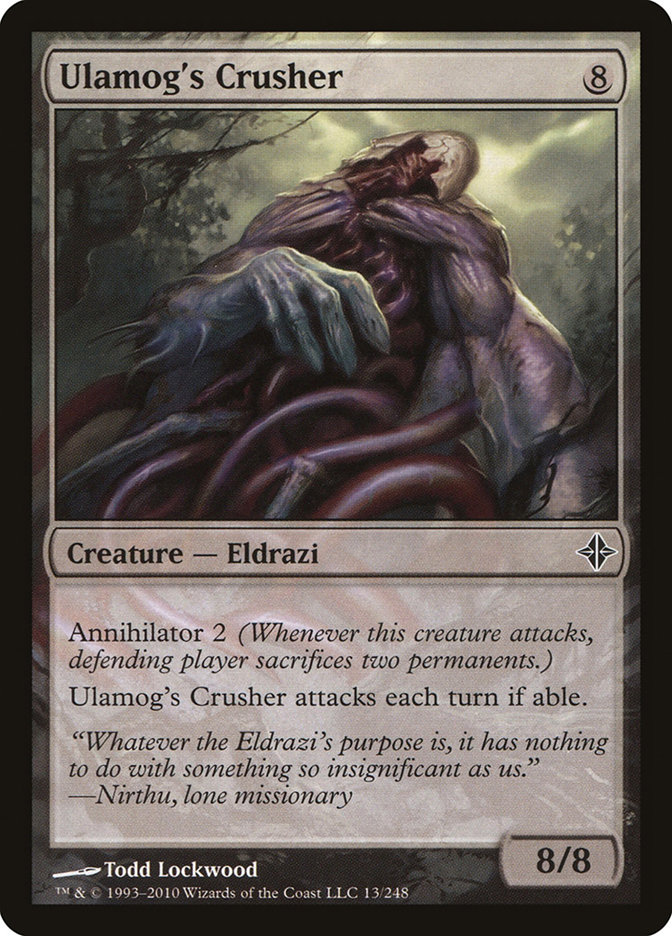
Setup
Before the game begins, make sure the cards from the Vanguard and Dreadnought decks are separated. Set aside the card “Coax From the Blind Eternities” and shuffle each deck. Place them both in the Horde’s play area. Place “Coax From the Blind Eternities” face up on top of the Dreadnought deck.
The Vanguard Deck
Tokens
Eldrazi Spawn

The role of Eldrazi Spawn Tokens is fundamentally different than the role of Token creatures in other Horde decks. Though they are creatures, they are not a resource for pushing damage toward the Survivors. They cannot attack, and like other Horde creatures, will never block unless forced to do so by an effect or ability.
Errata for Eldrazi Spawn
Eldrazi Spawn cannot attack.
Rather, they are a resource used to cast far greater threats than anything in the Vanguard deck. The top card of the Dreadnought deck is always revealed. Keep your eye on its Mana Cost…when there are enough Eldrazi Spawn on the battlefield to cast it, the Horde will sacrifice them to cast it.
Directive:
IF there are sufficient Eldrazi Spawn on the battlefield to cast the top card of the Dreadnought deck, sacrifice those Eldrazi Spawn for mana and cast that card.
Note that the Dreadnaught deck is in the Command zone, and the Horde’s ability to cast spells for 0 mana is specifically worded to state it may cast cards “from its hand” in this way. Hence, the need for a mana source in this deck but not the others.
Hunting Spawn
All Survivor creatures are granted a special instance of the Hunting ability throughout the game, which can only be used to target Eldrazi Spawn.
{{rulestext,font-family:”trebuchet ms”,margin-left:15px,width:90%
This gives smaller creatures (which may serve as blockers against other Horde decks, but fare poorly against the larger creatures in this one) a purpose in the game, as well as presenting an interesting choice to the Survivors - to dedicate their resources toward attacking the Vanguard deck directly, or toward delaying the arrival of the Dreadnought threats.
Eldrazi Horror
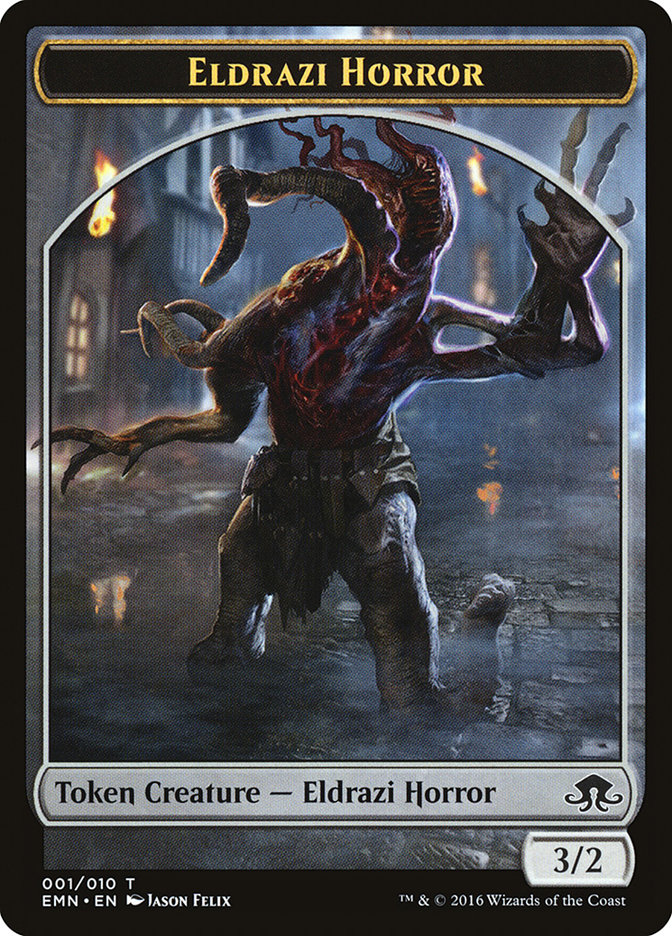
In contrast to the specialized role of the Eldrazi Spawn in the deck, Eldrazi Horror Tokens serve precisely the same role as the creature tokens in the other decks - they pressure the Survivors’ life total, compelling them to balance the benefits of aggression with the necessity of defense.

Token Generators
The creature density of the Vanguard deck is a bit lower than the other Horde decks, but the creatures that are included bring along Spawn to hasten the arrival of the Dreadnought threats.
Dread Drone
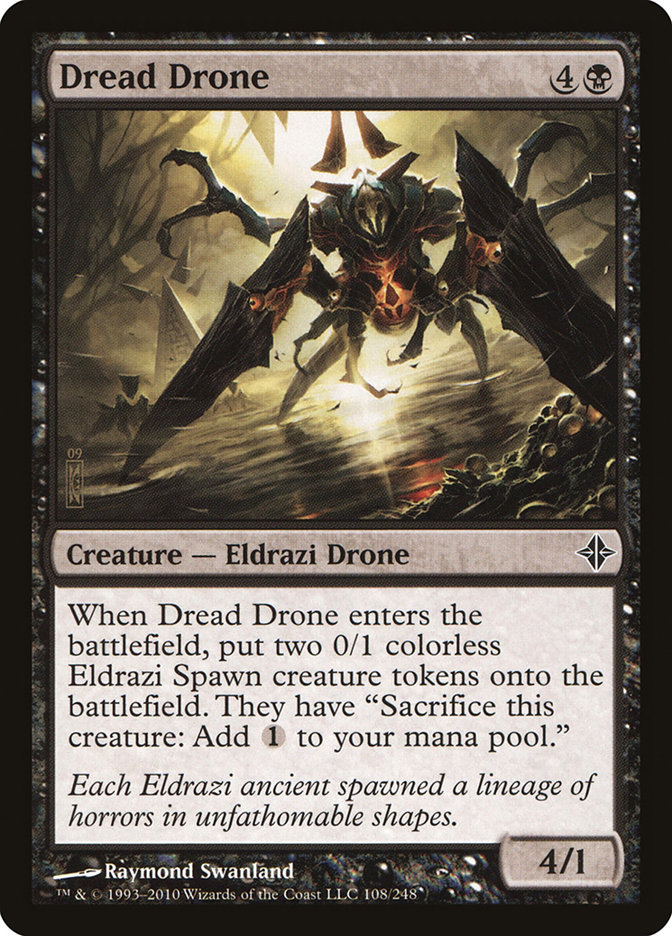
Emrakul’s Hatcher
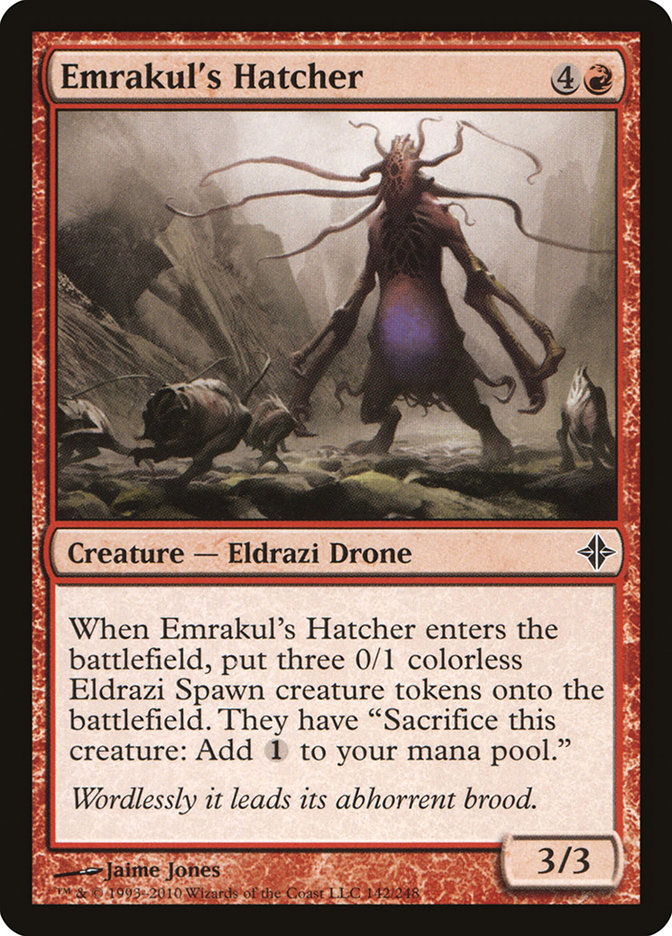
Kozilek’s Predator
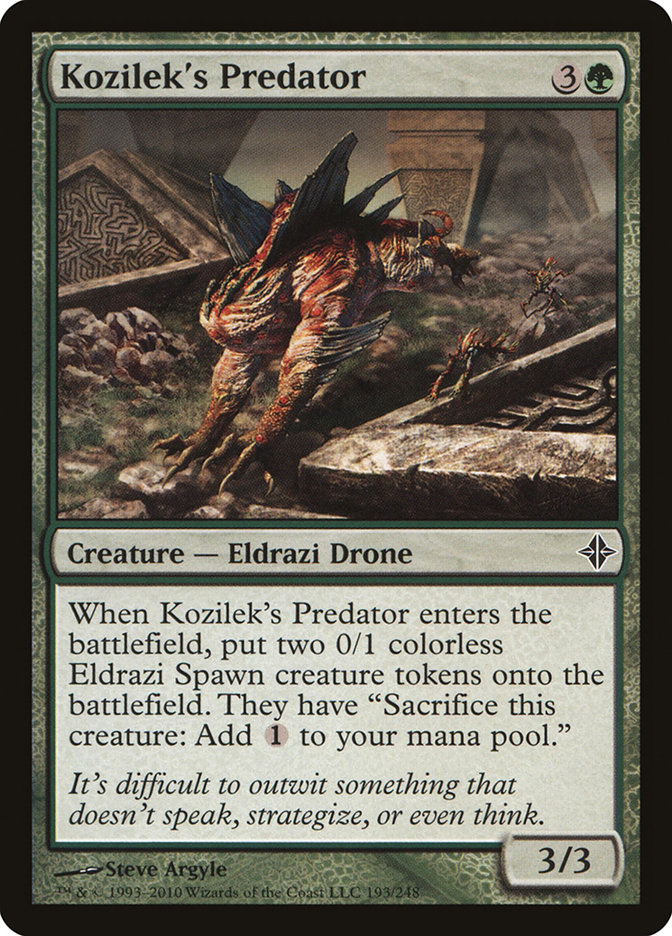
Brood Birthing

So many of the Vanguard decks cards create Eldrazi Spawn and cause other problems for the Survivor that these effects, only adding Spawn to the board, can actually be a relief.
Skittering Invasion


Removal
Unlike the other Horde decks, the Eldarazi have a significant and powerful removal suite. While the existence of the Dreadnought deck encourages the Survivors to spend their resources killing Spawn to prevent enormous threats from hitting the battlefield, these removal spells push the Survivors in the opposite direction, toward grinding through the Vanguard deck as quickly as possible before their forces are destroyed, or worse, exiled.
Consume the Meek
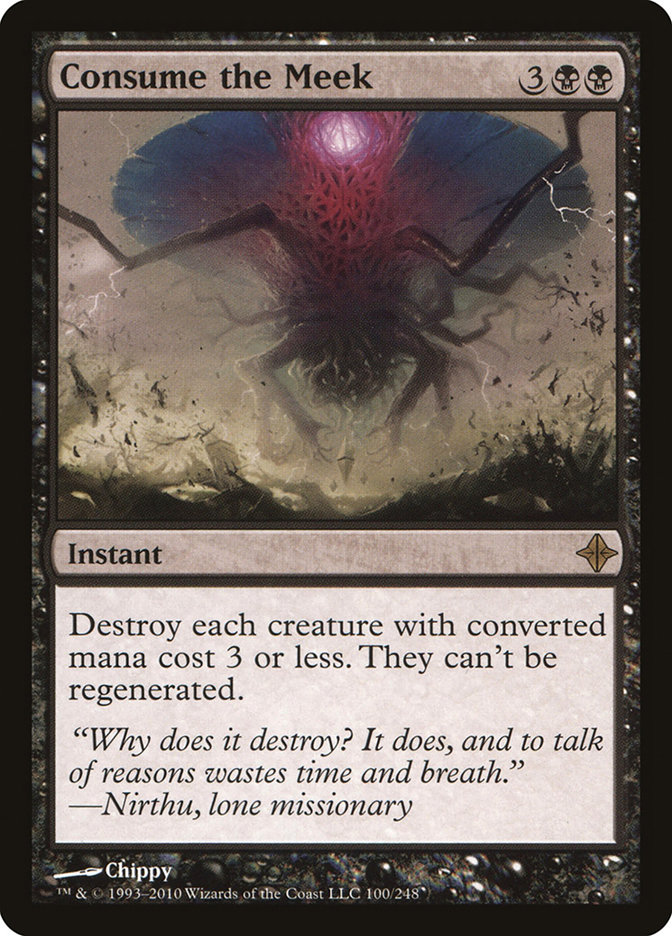
Whenever this sweeper is cast, it near-universally feels like the worst possible time. It’s saving grace is that it hits both sides of the battlefield. So, it at least has a chance of taking quite a few Eldrazi Spawn with it.
Corpsehatch

Errata for Corpsehatch
Destroy target nonblack creature.
Between Corpsehatch and Scour from Existence, there are six single-target removal spells in this Horde deck. If that doesn’t sound like a large number out of 50, it will after you play against the deck a few times. Both follow standard Horde targeting rules, so will hit the highest Mana Value target under Survivor control.
Scour from Existence


Card Draw
Exultant Cultist

The Cultist’s ideal role in the Eldritch Moon draft environment was as fodder for an Emerge cost. Here it has a chance to reprise that role, which can lead to some quite explosive Horde turns.
Essence Feed
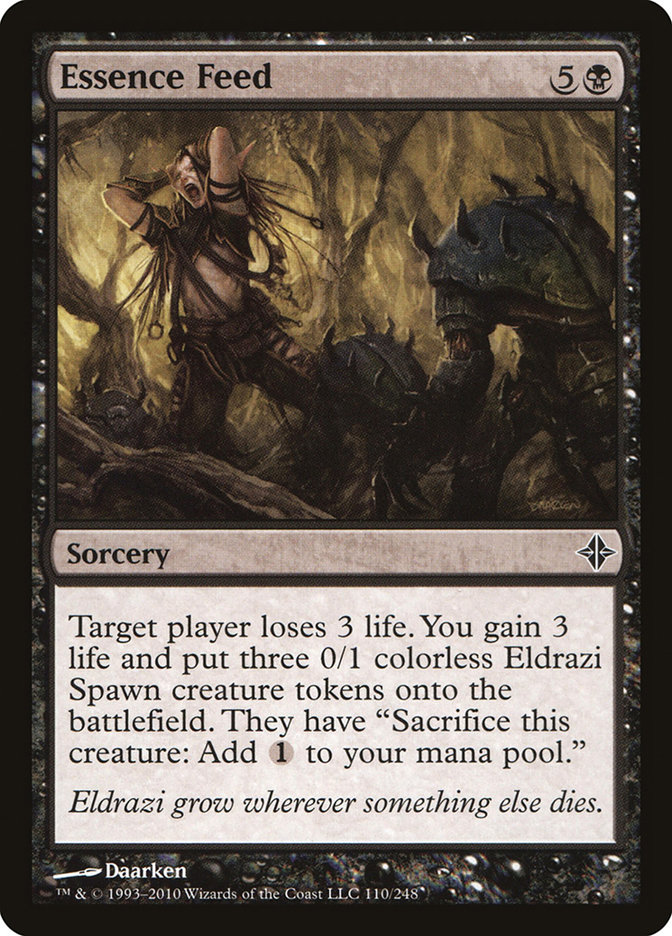
As described under “Interacting With the Horde,” the Horde doesn’t have a life total, but instead draws (and immediately casts) a card for every 3 points of life it would gain.

The Dreadnought Deck
The Dreadnought deck itself, and the cards within it, start the game in the Command zone. Once they are cast, they move between zones like normal (it’s advisable to sleeve them in a different colored sleeve than the Vanguard deck for easier separation between games).
Coax From the Blind Eternities
Before the Horde can start summoning unfathomable monstrosities from outside of time and space, it must open a door .
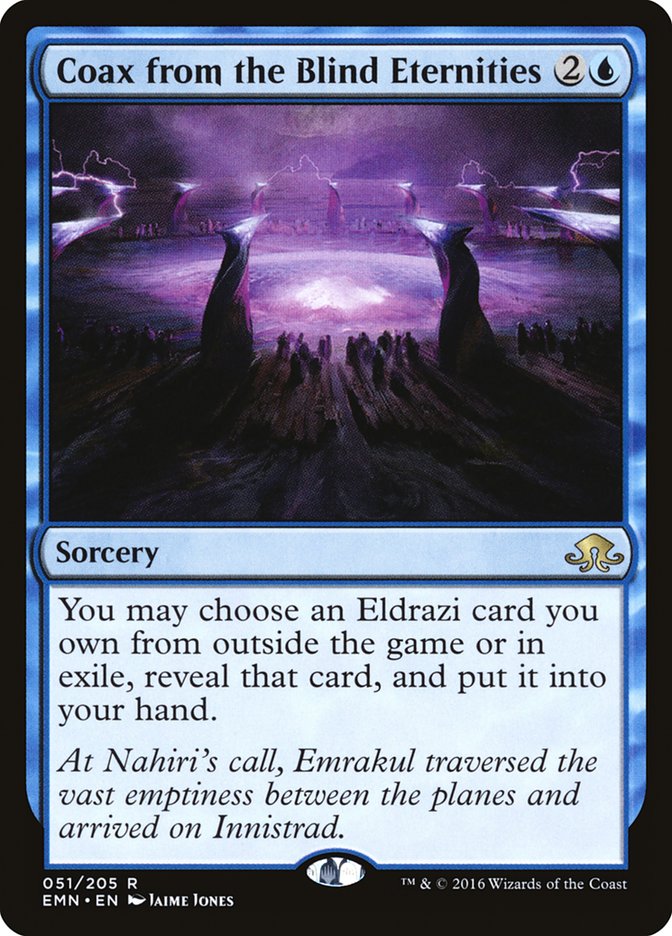
At the start of each game against the Eldrazi Horde, Coax from the Blind Eternities is the top card of the Dreadnought deck, and therefore will be the first to be cast. Its rules text is ignored…simply casting it to reveal the next card “unlocks” the rest of the deck. Also, since cards in the Dreadnought deck are not subject to the Horde’s usual alternative casting cost options, there is errata to eliminate the blue mana requirement from this spell’s Mana Cost.
Errata for Coax from the Blind Eternities
You may cast this spell by paying 3 colorless mana instead of its casting cost.
You may reveal an Eldrazi card you own from outside the game or choose a face-up Eldrazi card you own in exile. Put that card into your hand.
Emerge Creatures
Emerge is an ability on certain large Eldrazi creatures that provides an alternative casting cost. This alternative cost is always lower than the regular Mana Cost, but includes at least one colored mana symbol (in contrast with the regular Mana Cost of these creatures, which is always colorless). Additionally, a creature must be sacrificed to pay this alternative casting cost, and the Emerge cost is reduced by the Mana Value of that creature.
Limited Horde rules provide errata for the Emerge ability itself, so the sacrificed creature’s Mana Cost (including colored mana symbols) is used to reduce the alternative casting cost, not just its Mana Value (which only reduces the generic mana requirement).
Errata for Emerge (CR 702.119a)
If you chose to pay this spell’s Emerge cost, its total cost is reduced by an amount of generic mana equal to the sacrificed creature’s Mana value Cost.”
Emerge is never the Horde’s first choice - it will always try to play cards from the Dreadnought deck for their Mana Cost first. Only if it cannot will it check to see if it has the resources to cast those cards using Emerge - and if it does, it will proceed to do so.
Directive:
IF there are insufficient Eldrazi Spawn on the battlefield to cast the top card of the Dreadnought deck for its Mana Cost, BUT there are a sufficient combination of Eldrazi Spawn and a creature with suitable Mana Cost to pay that card’s Emerge cost, THEN sacrifice those creatures and cast that card for its Emerge cost.
The Vanguard deck includes, for each relevant color, only a few copies of one creature with suitable Mana Cost to pay for Emerge. Consequently, Eldrazi aren’t typically cast for their Emerge costs, but it happens often enough to punish Survivors who don’t prepare for the possibility.



Wretched Gryff

Abundant Maw
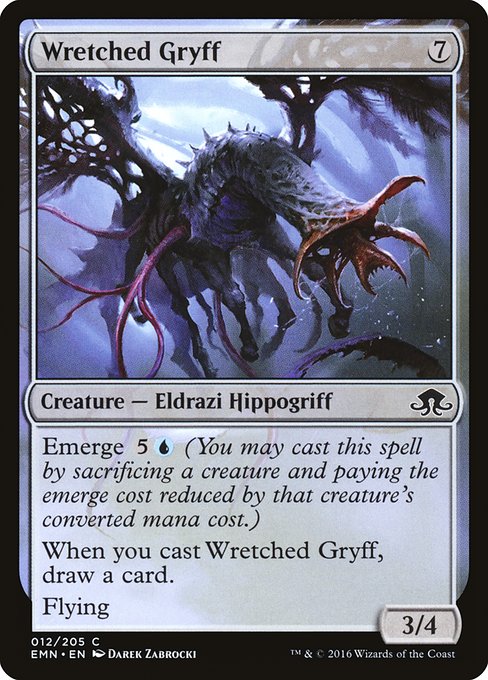
Since the Horde draws a card for every 3 life gained, these two play out very similarly. As soon as the creature resolves, the Horde plays another spell.
Drownyard Behemoth

It of the Horrid Swarm
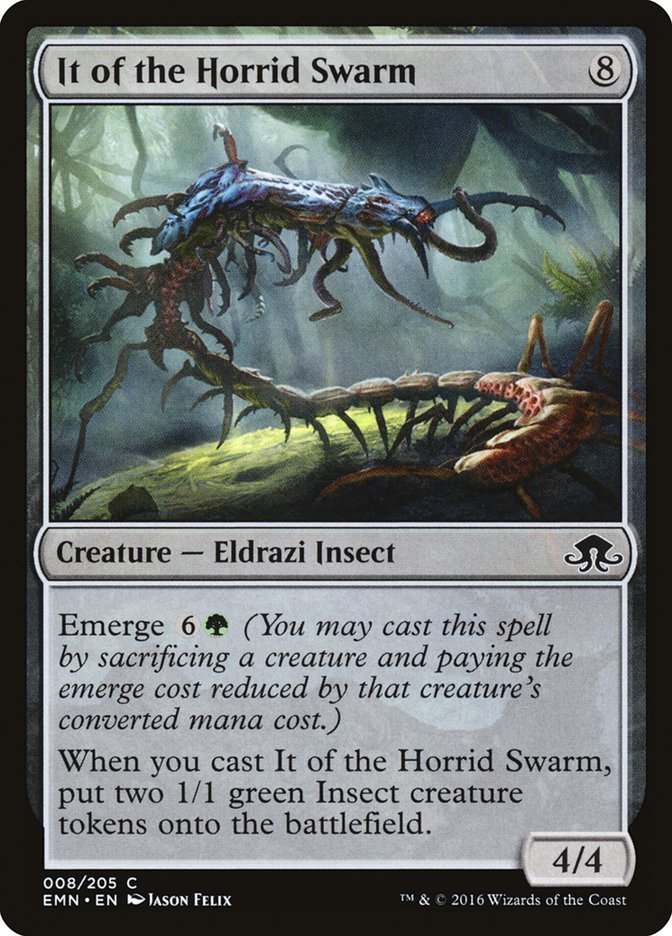
Rather than introducing another Token type to the deck, It of the Horrid Swarm will attempt to return Horrors to the battlefield, and will settle for Spawn.
Errata for It of the Horrid Swarm
When you cast It of the Horrid Swarm, return up to two tokens with the greatest Mana Values from your graveyard to the battlefield.
Mockery of Nature
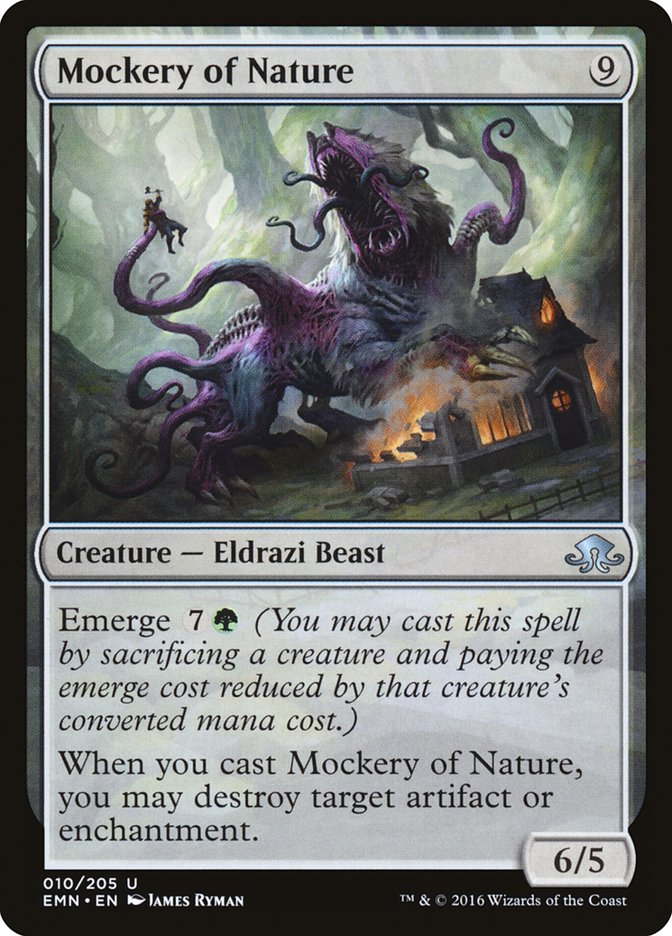
The Mockery will use standard Horde targeting rules, destroying the highest Mana Value target under Survivor control.
(Un)emerge(able) Creatures
Some Emerge costs include multiple colored mana symbols. However, only one creature may be sacrificed to pay for an instance of Emerge, and all of the creatures in the Vanguard deck include only a single colored mana symbol in their costs. Hence, these creatures will only be cast for their full Mana Cost.
Elder Deep-Fiend
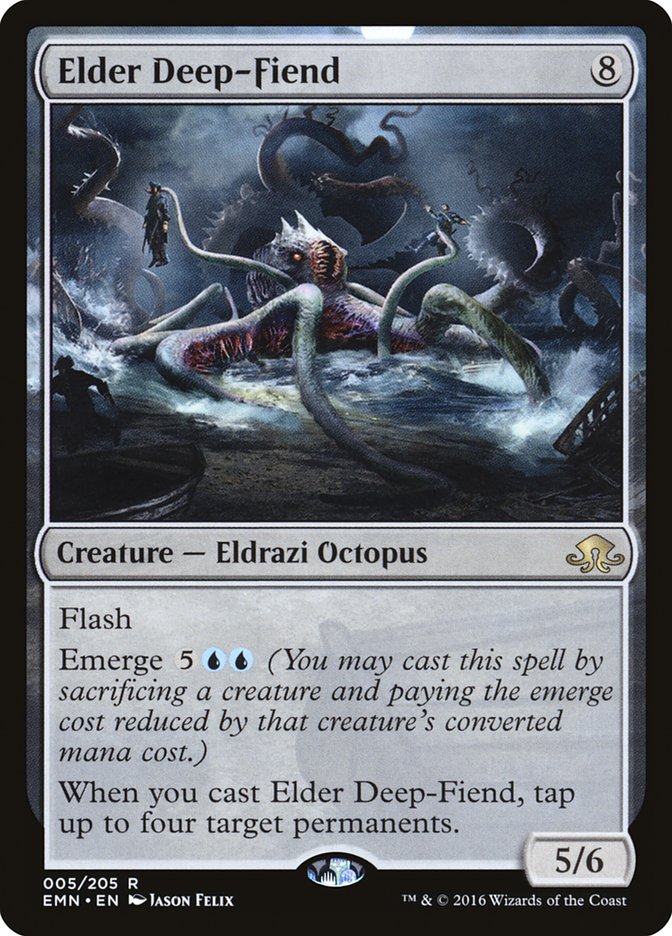
This is the one of only two cards in the Dreadnought deck that may be cast at Instant speed (the other being Drownyard Behemoth). This is unlikely to happen frequently, but the possibility does exist within the normal functioning of the deck, if (for example) an Exultant Cultist were to die in combat.
Directive:
IF the Horde casts Elder Deep-Fiend, it will select only untapped targets for its triggered ability. Those targets are chosen using the following priorities (in descending order):
- Creatures
- Other permanents with activated abilities that include tapping in their costs
- Lands
- All other permanents
Within each of these categories, standard Horde targeting rules (highest mana value first) apply.
Distended Mindbender

Following standard Horde targeting guidelines, the Horde will choose the highest Mana Value card within each range specified by Distended Mindbender. So, assuming the Survivors have spells in both ranges in had, they will have to discard both the highest Mana Value card of those up to Mana Value 3, and the overall highest Mana Value card. Ties are broken randomly.
Lashweed Lurker
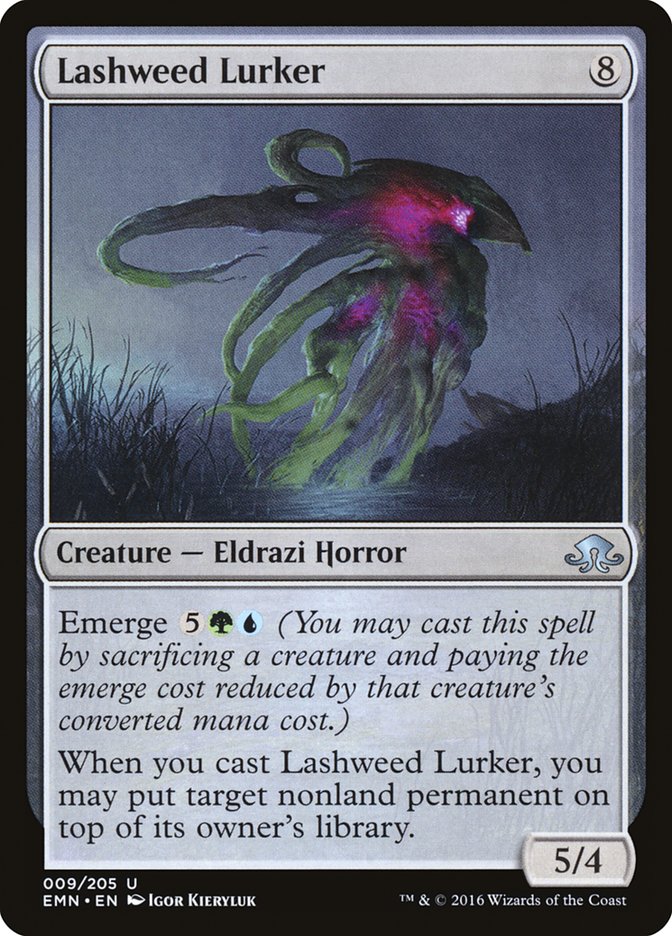
The lurker is another simple case - it will target the single highest-cost permanent the Survivors control.
Annihilator
Perhaps the most brutal mechanic in Magic, Annihilator is certainly the most devastating weapon in the Horde’s arsenal.
Ulamog’s Crusher

These monstrosities need no assistance threatening the Survivors…those with abilities beyond Annihilator have those abilities errated out.
Artisan of Kozilek

Errata for Artisan of Kozilek
When you cast this spell, you may return target creature card from your graveyard to the battlefield.
Annihilator 2.
Hand of Emrakul
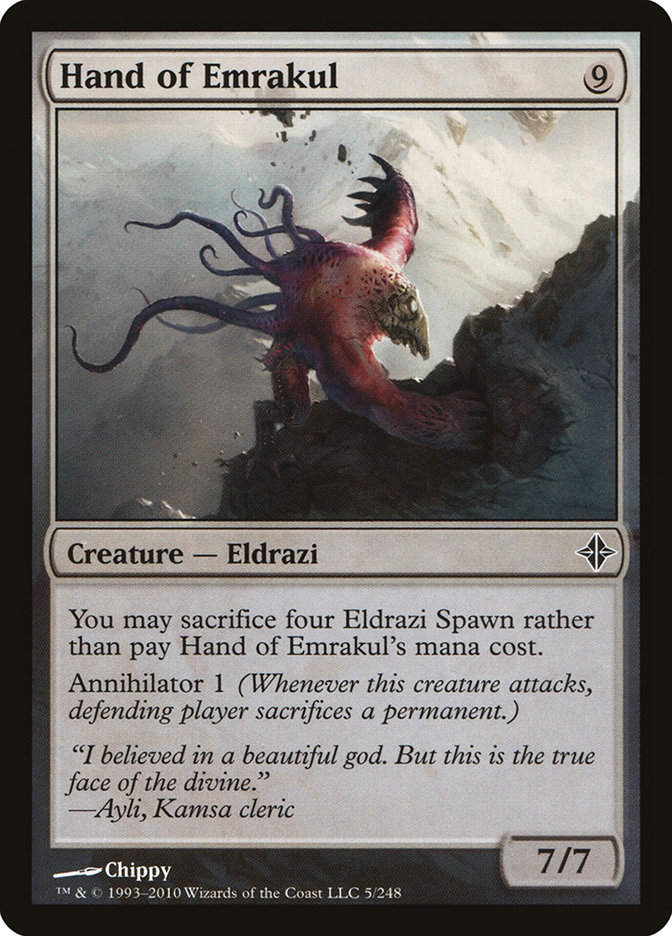
Errata for Hand of Emrakul
You may sacrifice four Eldrazi Spawn rather than pay this spell’s mana cost.
Annihilator 1
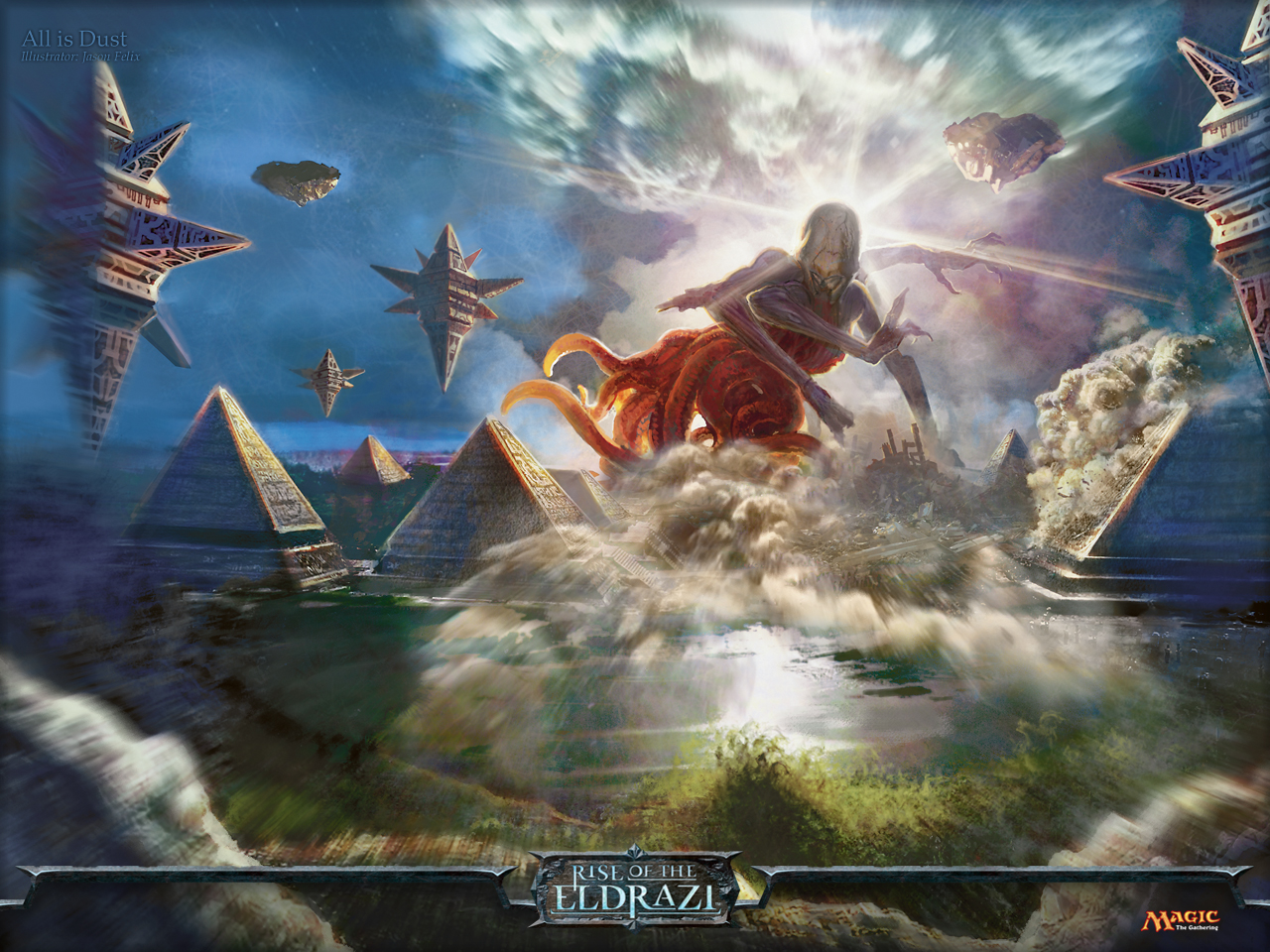
Appendix A - Master Directive Chart
For those who would prefer a formal, programmatic list to the prose of the main document, here is the Horde’s complete algorithm for the core game (i.e., excluding all the deck-specific Directives):
Directive:
Make all choices randomly unless instructed to do otherwise.
If required to tap creatures for mana, tap the creature or combination of creatures that results in the least excess mana being generated. In any case of ambiguity, choose at random.
If there are no cards remaining in the Horde library, and a game rule or Directive would cause a card to be drawn, instead do not draw a card.
If a game rule or Directive requires that a certain number of cards be drawn, and playing one of the cards drawn this way causes additional cards to be drawn and/or played during its resolution, those additional cards do not count toward the game rule or Directive’s requirement
When given priority by the game, check the following conditions. If none are true, pass priority:
IF one are more cards are in hand, play them immediately in the sequence they were drawn, fully resolving one before playing the next. If the sequence in which they were drawn is indeterminate, play them in a random order.
IF it is the beginning of the Horde’s First Main Phase AND the game is in either the Assault or Surge stage, THEN draw and play one card at a time until EITHER three cards have been drawn and played OR a non-Token card has been drawn and played. THEN, IF if the game is in the Surge stage, draw and play an additional two cards.
IF it is the Declare Attackers step on the Horde’s turn, attack with each creature able to do so. Attack a Planeswalker if the Survivors control one (if there are multiple, choose one at random for all Horde creatures to attack).
IF multiple blockers are assigned to one or more Horde attackers, assign exactly lethal damage to each blocker, prioritizing in descending priority: The blocker with the high toughness, the largest number of blockers, the blocker it can bring nearest to lethal damage. In any case of ambiguity, choose at random.
If an ability or effect on the stack would prevent the Horde from taking any action that it would otherwise take or would deprive the Horde of resources (cards or permanents) it would otherwise have unless mana is paid, tap creatures to pay that mana if possible.
Additionally, the Horde has an Emblem with the following abilities:
You may cast spells from your hand as though they had Flash.
When casting a spell from your hand, you may pay 0 instead of that spell’s casting cost.
You may note (at least) one contradiction between this algorithm and the text in the body of this document - the instruction to generally make the “correct” choice for the Horde when it is “obvious” is not addressed here. The difficult problem of codifying intuition and “judgment calls” has stumped far greater minds than mine. Among the benefits of a solitaire format are that you, the player, have no one to answer to but yourself. If it enhances your enjoyment of the game to make the “obviously correct” call on the Horde’s behalf on the occasions when it is obvious to you, then by all means, do so. If, on the other hand, you prefer a more predictable system from the outset, then feel free to leave to chance any decision that is not clearly laid out in the instructions above. I suggest only that you determine which approach you will take before beginning any given game, as that has, in my own past experience, been of far greater import to my enjoyment than the precise choice itself.
Appendix B - Decklists for Import
Online Deck Builders
The mechanics of Limited Horde aren’t perfectly matched to the playtest capabilities in tools like Archidekt or Moxfield, but either will do in a pinch. The most significant problem is that you cannot put tokens in these decks. To work around this, vanilla creatures with the appropriate stats have been included instead. The second problem is that determining when Surge phase begins can easily be determined with a physical height comparison in paper, but you’ll need to keep track of the sum total of the cards in graveyard + exile at the beginning of each Horde turn.
Zombies
1 Advanced Stitchwing
2 Blighted Bat
2 Crow of Dark Tidings
1 Cursed Minotaur
2 Diregraf Captain
2 Gavony Unhallowed
2 Graf Harvest
2 Hound of the Farbogs
2 Miasmic Mummy
1 Noosegraf Mob
2 Rancid Rats
2 Rottenheart Ghoul
2 Smallpox
1 Stitchwing Skaab
2 Terrus Wurm
1 Thraben Foulbloods
23 Walking Corpse
Goblins
25 Mons's Goblin Raiders
2 Goblin Caves
2 Goblin Shrine
2 Goblin Oriflamme
1 Goblin War Drums
1 Raid Bombardment
2 Goblin Marshal
2 Siege-Gang Commander
1 Goblin Rabblemaster
3 You See a Pair of Goblins
1 Goblin War Strike
1 Volley Veteran
2 Goblin Chainwhirler
2 Goblin Trashmaster
1 Goblin Pyromancer
1 Ib Halfheart, Goblin Tactician
1 Pashalik Mons
Eldrazi
2 Brood Birthing
2 Consume the Meek
3 Corpsehatch
3 Dread Drone
2 Emrakul's Hatcher
3 Essence Feed
3 Exultant Cultist
20 Hedron Crawler
3 Kozilek's Predator
5 Kozilek's Shrieker
2 Scour from Existence
2 Skittering Invasion
Sideboard
1 Abundant Maw
1 Artisan of Kozilek
1 Coax from the Blind Eternities
1 Distended Mindbender
1 Drownyard Behemoth
1 Elder Deep-Fiend
1 Hand of Emrakul
1 It of the Horrid Swarm
1 Lashweed Lurker
1 Mockery of Nature
1 Ulamog's Crusher
1 Wretched Gryff
Proxy Printers
The decklists are fairly inexpensive, but if you want to get going quickly, printing proxies at home is a useful option. Tested with https://www.mtg-print.com/. The primary distinction here is omitting the word “Token.” You’ll likely want to check the default art selected (particularly for the Tokens), and adjust to taste.
Zombies
1 Advanced Stitchwing
2 Blighted Bat
2 Crow of Dark Tidings
1 Cursed Minotaur
2 Diregraf Captain
2 Gavony Unhallowed
2 Graf Harvest
2 Hound of the Farbogs
2 Miasmic Mummy
1 Noosegraf Mob
2 Rancid Rats
2 Rottenheart Ghoul
2 Smallpox
1 Stitchwing Skaab
2 Zombie Giant
1 Thraben Foulbloods
23 Zombie
Goblins
2 Goblin Caves
2 Goblin Chainwhirler
2 Goblin Marshal
2 Goblin Oriflamme
1 Goblin Pyromancer
1 Goblin Rabblemaster
2 Goblin Shrine
2 Goblin Trashmaster
1 Goblin War Drums
1 Goblin War Strike
1 Ib Halfheart, Goblin Tactician
1 Pashalik Mons
1 Raid Bombardment
2 Siege-Gang Commander
1 Volley Veteran
3 You See a Pair of Goblins
25 Goblin
Eldrazi
2 Brood Birthing
2 Consume the Meek
3 Corpsehatch
3 Dread Drone
2 Emrakul's Hatcher
3 Essence Feed
3 Exultant Cultist
3 Kozilek's Predator
2 Scour from Existence
2 Skittering Invasion
5 Eldrazi Horror
20 Eldrazi Spawn
1 Abundant Maw
1 Artisan of Kozilek
1 Coax from the Blind Eternities
1 Distended Mindbender
1 Drownyard Behemoth
1 Elder Deep-Fiend
1 Hand of Emrakul
1 It of the Horrid Swarm
1 Lashweed Lurker
1 Mockery of Nature
1 Ulamog's Crusher
1 Wretched Gryff
Buylists
Tested with TCGPlayer’s Mass Entry function (https://www.tcgplayer.com/massentry).
Zombies
$6.33 plus shipping, searched on 10/21/22
1 Advanced Stitchwing
2 Blighted Bat
2 Crow of Dark Tidings
1 Cursed Minotaur
2 Diregraf Captain
2 Gavony Unhallowed
2 Graf Harvest
2 Hound of the Farbogs
2 Miasmic Mummy
1 Noosegraf Mob
2 Rancid Rats
2 Rottenheart Ghoul
2 Smallpox
1 Stitchwing Skaab
2 Zombie Giant Token
1 Thraben Foulbloods
23 Zombie Token
Goblins
$27.20 plus shipping, searched on 10/23/22
2 Goblin Caves
2 Goblin Chainwhirler
2 Goblin Marshal
2 Goblin Oriflamme
1 Goblin Pyromancer
1 Goblin Rabblemaster
2 Goblin Shrine
2 Goblin Trashmaster
1 Goblin War Drums
1 Goblin War Strike
1 Ib Halfheart, Goblin Tactician
1 Pashalik Mons
1 Raid Bombardment
2 Siege-Gang Commander
1 Volley Veteran
3 You See a Pair of Goblins
25 Goblin Token
Eldrazi
$11.95 plus shipping, searched on 10/23/22
2 Brood Birthing
2 Consume the Meek
3 Corpsehatch
3 Dread Drone
2 Emrakul's Hatcher
3 Essence Feed
3 Exultant Cultist
3 Kozilek's Predator
2 Scour from Existence
2 Skittering Invasion
5 Eldrazi Horror Token
20 Eldrazi Spawn Token
1 Abundant Maw
1 Artisan of Kozilek
1 Coax from the Blind Eternities
1 Distended Mindbender
1 Drownyard Behemoth
1 Elder Deep-Fiend
1 Hand of Emrakul
1 It of the Horrid Swarm
1 Lashweed Lurker
1 Mockery of Nature
1 Ulamog's Crusher
1 Wretched Gryff
Appendix C - Horde Magic Resources
Origins
Horde Magic was invented by Peter Knudson in 2011 as a PvE format for one to four players with Commander decks.
Horde Magic: A New Way to Play Magic and Survive Zombie Invasions Peter Knudson, September 29, 2011 The introduction of the format as designed for 1-4 Survivors playing Commander decks. Includes the initial rule set, 100 card Zombie Horde deck, and some thoughts on the design philosophy
Horde Magic: An Open Source Project Peter Knudson, October 26, 2011 A summary of, and response to, early coverage of the format. Includes more discussion of design philosophy, some alternate card choices for the original Zombie Horde deck, a format ban list, a Survivor pre-con decklist, and three new Horde decklists (Slivers, Cats, and Merfolk).
Articles
2011
When Zombie Attack: Horde Mage Robby Rothe, October 13, 2011 One of the earliest responses to the format, mostly reiterating the concept, but also with some tuning recommendations and a Survivor pre-con decklist.
Up Up Down Down Left Right Left Right B A Shuffle Adam Styborski, October 18, 2011 Article on the Mothership (i.e., official Wizards site) describing the format. Link currently broken due to WotC’s revamp of their content site.
2012
Then We Will Fight In the Shade! Adam Styborski, February 12, 2012 Stitched In The Middle With You Adam Styborski, February 28, 2012 More Mothership articles, primarily focussed on tweaking the original Horde deck to increase difficulty.
2013
Horde Magic 2.0: Introducing the Raid Peter Knudson, February 13, 2013 A follow up article from the inventor of the format, including a Rat Horde deck, and a format variant where the Horde deck is divided into different stages (the cards within each stage are randomized, the sequence of the stage is predetermined) to add story/role-play elements.
2014
Super Horde Magic Zombies Decklist by welknair (TappedOut user) Offers some rule variants to increase the difficulty of the game, collectively named “Super Horde Magic.” Includes links to other Super Horde decks by welknair: Eldrazi, Goblins, Giants, Slivers, Minotaurs, Dragons, Phyrexians The Hunting mechanic in Limited Horde is borrowed directly from welknair’s designs.
2020
Commander in the Time of Coronavirus: Horde Magic by Mark Wischkaemper Includes a brief history of the format, and an original Rats Horde deck.
2022
The Horde Format Revisited (Reddit thread by author) The Horde Format Revisited (Rulebook with deck links) In this follow up post to a project began four years prior, Redditor u/TenkayCrit presents a polished and tuned pre-constructed variant with a beautifully formatted rulebook. Per the rulebook, this variant is designed as more of a boardgame-type experience, with four 60-card pre-constructured player decks headed by the dual-faced creature-planeswalker cards from Magic Origins. The project includes eight Horde decks, and introduces a Looting mechanic.
Horde Magic Compendium xram666 (TappedOut user) A consolidated resource with a clean summary of current core Horde rules and links to many Horde decks on TappedOut.
Communities
Horde Magic Subreddit https://www.reddit.com/r/hordemtg/
Appendix D - Aggro Mode
As mentioned in the “How to Play” section above, the deck and rules described in this document are designed and tuned for play midrange decks. Magic Pros have been known to describe Limited as a fundamentally midrange format, and that nearly all Limited decks actually are Midrange, with some just having an Aggro or a Control bias. Of the decks used in playtesting, which were generally pulled from recordings well-known streamers or podcasters, or Pro Tour reports, 80-90% of the decks used in playtesting seemed well suited for Limited Horde as currently designed. Those that tended particularly toward the Control end of the spectrum fared well, but the 10-20% of decks furthest on the Aggro end of the spectrum could get essentially no wins versus the Horde.
In regular, PvP Magic, Aggro decks rely on a form of virtual card advantage - they end the game before the opponent can get any use out of most of their cards, and they often rely heavily on combat tricks to win combat when the opponent is forced to block. But, the Horde never blocks, and requires far more than the usual 20 damage to defeat, and so otherwise high-quality Aggro decks will typically get overrun between turns 9 and 12.
These rules adjustments may lead to the Limited Horde decks providing a more manageable challenge versus Aggro Survivor decks:
1 point of damage mills 1 card from the Horde deck (down from 3).
The Surge stage does not occur (so the Horde will never play more than 3 cards per turn).
All Survivor creatures have the Hunting ability throughout the game.
These three rules changes lead to a very different type of gameplay (though, notably, the first two changes actually revert the game toward “rules as written” for original Horde Magic). Playtesting in this mode has been very limited, but appeared to result in the vicinity of a 50% win rate with 3 Preparation turns against decks from Pro Tour Amonkhet’s Top 8, which was a famously aggro-heavy format).
Pin Down
This is a potential mechanic in early testing, with even less test data than the above. If giving all Survivors the Hunting ability carte blanche overcorrects, making the game too easy for Survivors, try giving all creatures this ability instead:
{{rulestext,font-family:”trebuchet ms”,margin-left:15px,width:90%
Appendix E - Multiplayer
The 1.0 version of this document included a 2-player version of the Zombies decklist. Developing and tuning 2-player variants of the decks is on the list of things I’d like to do, but that is a very long list, and i’m not optimistic about this making it up to the top. Until and unless someone else has the resources and desire to undertake this development effort, I’m going to leave these tentative recommendations as a guidelines/starting point.
For each player beyond the first, the Horde plays an additional card each turn. Once the Surge hits, add another card per player.
All Survivors are on the same team, using Two-Headed Giant rules as a baseline. This includes taking their turn simultaneously, sharing a life total (still starting at 30), and attacking and blocking as a single entity.
Appendix F - Design Notes
Mechanical Identity
One of my reference points for this project were the PvE “Challenge Decks” that WoTC published with original Theros block. Each of those had very distinct mechanics, which made learning to play them a bit more complicated than I would consider ideal. In attempting to create some variety of play experience, and perhaps more critically, to avoid rewarding deckbuilding specifically to the weakness of one specific Horde deck, I concluded this model is worthwhile.
For example, in version 1.0 of this document (where Zombies was the only deck), you’ll find just one Graf Harvest, and a Bad Moon. Anthem effects (i.e., the Bad Moon) are a staple of original Horde, but I found that building up powerful enchantments that many decks can’t interact with was an unfun form of variance. So, Bad Moon was replaced with Diregraf Captain, which is both on theme and can be killed in combat. To get around the potential lack of Enchantment removal (which some colors simply do not have), Graf Harvest got its sacrifice clause. But, more fundamentally, with the Directive for the Horde to use its activated ability, Graf Harvest became The Thing the deck wants to. Without a doubt, it is cumbersome to physically play out if it gets played mid-game - you have to calculate which creatures will tap for mana, make sure there are both Tokens and non-Tokens in the graveyard, and likely repeat that process multiple times. But, the flavor is perfect for a Zombie deck, and it generates substantially different play patterns than the other Horde decks.
The Surge
In early playtesting, nearly every game came down to a single inflection point where the Survivors would stabilize or get overrun…if they stabilized, they would nearly universally be able to continue to develop their board and win virtually every game. The remaining turns tended to be protracted and boring. The Surge mechanic was introduced to add a sense of danger, and more consequential decision-making, to the late game. With the Surge, Survivors need to continue to develop their board presence to survive the final few turns. In the early and midgame, they have to weigh the rewards of attacking to mill additional Horde cards against the risk of triggering the Surge before they can handle it. Once the Surge begins, the game typically ends in 2-3 turns, either way.
Giving Small Creatures Purpose
There are multiple factors - chiefly, the implicitly large quantity of creatures in any Horde deck and the increased average mana quality given the Preparation stage - which reward Survivor decks for playing larger, more expensive creatures. Since the design goals of this format include getting additional play from decks built for PvP, incentives for players to build substantially different types of decks than they would versus human opponents are worth combatting.
One countering force is encouraging players to play against the Horde with as few Preparation turns as possible. Control decks in PvP are forced to have expensive spells of some type so they can survive against Aggro decks long enough to enact their game plan. In the same sense, a deck that knows it will reliably be able to cast at least two 4-drops before the Horde starts attacking has no incentive to run smaller creatures that may have to trade off…but if the Horde starts attacking on turn 3, a curve that starts at 4 will often be overwhelmed and lose before it can cast enough blockers.
Secondarily, each of the Horde decks has a mechanic that gives some utility to smaller creatures. Zombies is the weakest of these, in that a small creature can be used as a chump blocker to enable larger blockers to kill threats with Menace…this can be pivotal is a Graf Harvest is played during the Surge. In Goblins, the smaller creatures can be used to tear down Kluges, while larger creatures are reserved for blocking the following wave of tokens. In Eldrazi, all creatures are granted the ability to Hunt Eldrazi Spawn specifically so that lower-curve decks, which have a much harder time dealing with the large creatures in the Dreadnaught deck, can instead use their resources to delay the casting of those large creatures, so that they face fewer over the course of the game.
Appendix G - Format Winrates
The Brothers’ War
| Prep Turns: | 2 | 3 | 4 | 5 |
|---|---|---|---|---|
| Zombies | 0 % | 22% | 41% | 54% |
| Goblins | 25 % | 83% | 65% | 80% |
| Eldrazi | 32 % | 84% | 61% | 57% |
The value in each cell represents the winrate after roughly a dozen games against a combination of Draft and Sealed decks. Note that this data is based on the decklists as published in the 2.0 version of this document, and is the basis for the changes to the Zombies decklist in this version.
Revision History
Initial publication date: July 11, 2022 Any edits to this document will be noted here.
10/12/22 - begin integrating Goblin and Eldrazi decks.
10/23/22 - Ported to HomeBrewery.naturalcrit.com
10/24/22 - Final edit pass.
11/16/22 - Fixed Rottenheart Ghoul’s errata - I made a copy/paste error, and it was erroneously the same effect as Smallpox. Thanks for catching this, Redditor u/KanielDing.
12/20/22 - Updated to version 2.1, with the following modifications:
- Added to Horde turn structure and Master Directive Chart that the Horde will always attack Planeswalkers first.
- Added Appendix G, Format Winrates. The sample size is currently small, and I think statistical noise is the best explanation for the high winrates in the 3-prep-turn columns for Goblins and Eldrazi. The Zombies winrates were much lower across the board, and the games felt far more challenging than against the other two decks. While it’s entirely possible I’m being too hasty, and making changes based on insufficient data or the quirks of the Brothers’ War format, this led me to the following decklist modification, which thus far feels better in playtesting:
- Updated Zombie decklist, replacing two Zombie Giant Tokens with regular Zombie Tokens.
12/21/22 - Fixed missing hyperlinks in Appendix C, and added missing rules to Kluges about creating Goblin Tokens when destroyed. Thanks, Redditor u/Livefox96, for catching this omission.
12/22/22 Full spelling and grammar pass, at the wise recommendation of Redditor u/SidNYC.
Acknowledgements
This document is unofficial Fan Content permitted under the Wizards of the Coast Fan Content Policy. The literal and graphical information presented on this site about Magic: The Gathering, including but not limited to card images and art, is copyright Wizards of the Coast, LLC, a subsidiary of Hasbro, Inc.
Additional art by DeviantArt user EdCid.


